Paul van Yperen's Blog, page 382
May 18, 2015
Teddy Scholten
I am a chauvinist, to be honest. At least once a year. Yes, I am a European and I do like - nearly - all European film stars, but at the annual European Song Contest I hope that the Netherlands win. Every time when a jury member from Bosnia and Herzegovina or Malta declares: "Pays-bas... douze points", passionate yells rise from our home. Happily for our neighbours this does not happen too often and the last time 'we' won the event was in 1975 (!) with the band Teach-in and the song Ding-A-Dong. Today's post is about the winner of the Eurovision Song Contest 1959, Dutch singer Teddy Scholten (1926-2010) .
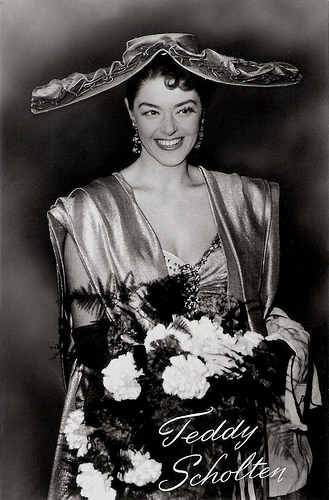
Dutch postcard by Uitg. Takken, Utrecht, no. 4018. Photo: 't Sticht, Utrecht. Great hat!
A Little Bit
Teddy Scholten was born Dorothea Margaretha van Zwieteren in 1926 in Rijswijk, close to The Hague, the capital of the Netherlands.
She met Henk Scholten, who became her fiancé in 1945. They married two years later. In the 1940s Teddy and Henk performed on stage as the duo Scholten & Van 't Zelfde.
In 1959 she was invited by the Dutch broadcasting company NTS to participate at the National Song Contest. She came, sang and conquered with the song Een beetje (A little bit), composed by Dick Schallies and with a text by Willy van Hemert.
Then, at the Eurovision Song Contest 1959 in Cannes, she became first again. Later, she would sing the song also in French, German and Italian versions. In 1965 as well as in 1966 she presented the Dutch National Song Contest.
During the 1950s and 1960s Teddy and her husband Henk hosted several TV programmes for the Dutch broadcasting company KRO, including the candid camera show Kiekeboe (1963). With her husband, she also recorded several albums, many of them containing songs for children.
Teddy Scholten died in 2010. She was 83. With Henk she had a daughter, René Scholten.
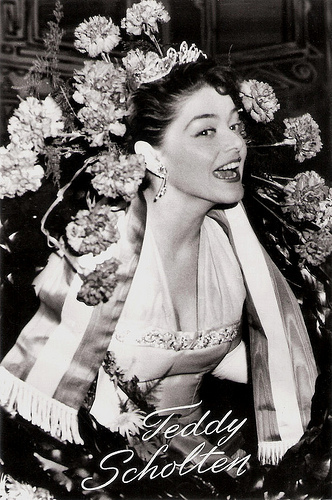
Dutch postcard by Uitg. Takken, Utrecht, no. 4000. Photo: 't Sticht, Utrecht.
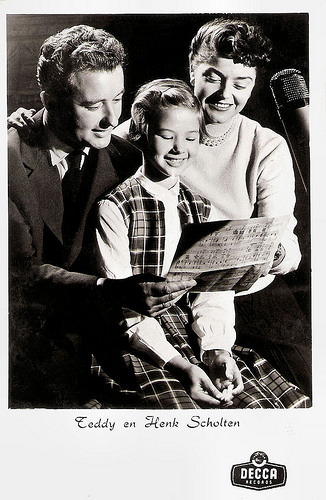
Teddy and Henk Scholten. Dutch postcard by Gebr. Spanjersberg N.V., Rotterdam, no. 5124. Photo: Decca Records / Editions Altona, Amsterdam.
The Amazing Conchita Wurst
So tonight the fun starts again with the first semi-final in Vienna, Austria. Tuesday 21 is the second semi-final and Saturday 23 is the big final!
Last year, the amazing Conchita Wurst won for Austria with the song Rise Like a Phoenix, and the Common Linnets came in second for the Netherlands.
This year, forty countries (including Australia!) will participate this in this 60th Eurovision Song contest and Trijntje Oosterhuis (try to say her name loud and proud, if you dare!) will represent the Netherlands tonight with the song Walk along.
We hope Trijntje does as well tonight as Teddy Scholten did in 1959. An the Dutch pronunciation of her name isˈtrɛiɲcə ˈoːstərˌɦœys];
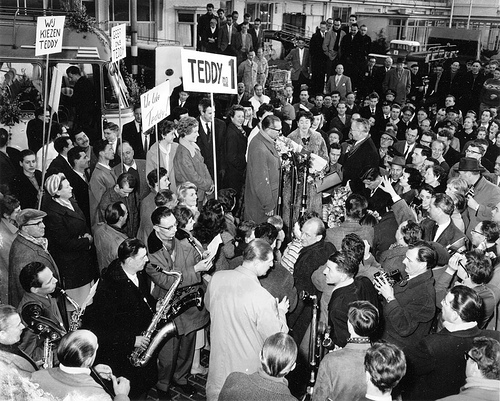
Teddy Scholten at the airport Schiphol after her siege at the Eurovision Song Contest 1959. Source: IISG (Flickr).
Teddy Scholten, winner at the Eurovision Song Contest 1959 with Een beetje. Source: God Kveld Norge and Oslo! (YouTube).
Clip of Trijntje Oosterhuis singing Walk along. Source: Eurovision Song Contest (YouTube).
Sources: nu.nl, Wikipedia and .

Dutch postcard by Uitg. Takken, Utrecht, no. 4018. Photo: 't Sticht, Utrecht. Great hat!
A Little Bit
Teddy Scholten was born Dorothea Margaretha van Zwieteren in 1926 in Rijswijk, close to The Hague, the capital of the Netherlands.
She met Henk Scholten, who became her fiancé in 1945. They married two years later. In the 1940s Teddy and Henk performed on stage as the duo Scholten & Van 't Zelfde.
In 1959 she was invited by the Dutch broadcasting company NTS to participate at the National Song Contest. She came, sang and conquered with the song Een beetje (A little bit), composed by Dick Schallies and with a text by Willy van Hemert.
Then, at the Eurovision Song Contest 1959 in Cannes, she became first again. Later, she would sing the song also in French, German and Italian versions. In 1965 as well as in 1966 she presented the Dutch National Song Contest.
During the 1950s and 1960s Teddy and her husband Henk hosted several TV programmes for the Dutch broadcasting company KRO, including the candid camera show Kiekeboe (1963). With her husband, she also recorded several albums, many of them containing songs for children.
Teddy Scholten died in 2010. She was 83. With Henk she had a daughter, René Scholten.

Dutch postcard by Uitg. Takken, Utrecht, no. 4000. Photo: 't Sticht, Utrecht.

Teddy and Henk Scholten. Dutch postcard by Gebr. Spanjersberg N.V., Rotterdam, no. 5124. Photo: Decca Records / Editions Altona, Amsterdam.
The Amazing Conchita Wurst
So tonight the fun starts again with the first semi-final in Vienna, Austria. Tuesday 21 is the second semi-final and Saturday 23 is the big final!
Last year, the amazing Conchita Wurst won for Austria with the song Rise Like a Phoenix, and the Common Linnets came in second for the Netherlands.
This year, forty countries (including Australia!) will participate this in this 60th Eurovision Song contest and Trijntje Oosterhuis (try to say her name loud and proud, if you dare!) will represent the Netherlands tonight with the song Walk along.
We hope Trijntje does as well tonight as Teddy Scholten did in 1959. An the Dutch pronunciation of her name isˈtrɛiɲcə ˈoːstərˌɦœys];

Teddy Scholten at the airport Schiphol after her siege at the Eurovision Song Contest 1959. Source: IISG (Flickr).
Teddy Scholten, winner at the Eurovision Song Contest 1959 with Een beetje. Source: God Kveld Norge and Oslo! (YouTube).
Clip of Trijntje Oosterhuis singing Walk along. Source: Eurovision Song Contest (YouTube).
Sources: nu.nl, Wikipedia and .
Published on May 18, 2015 22:00
May 17, 2015
Sacha Guitry
French actor, dramatist and director Sacha Guitry (1885-1957) was known for his stage performances, often in the more than 120 plays he wrote. Guitry's plays range from historical dramas to contemporary light comedies. From the 1930s to the end of his life, he enthusiastically embraced the cinema, making as many as five films in a single year. After his death, 12,000 people filed past his coffin before his burial in Paris.
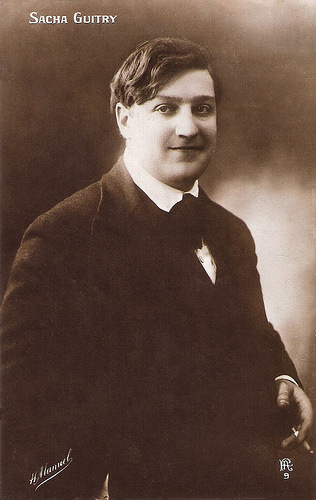
French postcard by F.A., no. 9. Photo: H. Manuel.
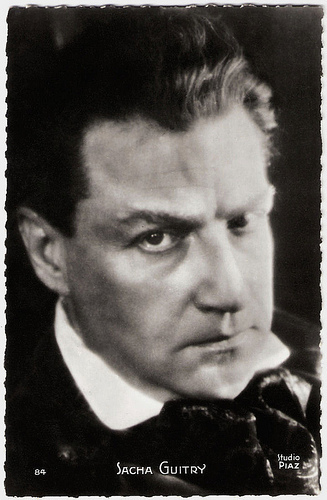
French postcard by Editions P.I., Paris, no. 84. Photo: Studio Piaz.
His own definitive interpreter
Alexandre-Pierre Georges ‘Sacha’ Guitry was born at Nevsky Prospect no. 12, Saint Petersburg, Russia, in 1885. He was the third son of the French actor Lucien Guitry and his wife Marie-Louise-Renée née Delmas de Pont-Jest. The couple had eloped, in the face of family disapproval, and were married at St Martin in the Fields, London, in 1882. They then moved to the Russian capital, where Lucien ran the French theatre company, the Théâtre Michel, from 1882 to 1891.
The marriage was brief. Guitry senior was a persistent adulterer, and his wife instituted divorce proceedings in 1888. Two of their sons died in infancy (one in 1883 and the other in 1887); the other surviving son, Jean became an actor and journalist. The family's Russian nurse habitually shortened Alexandre-Pierre's name to the Russian diminutive ‘Sacha’, by which he was known all his life.
The young Sacha made his stage debut in his father's company at the age of five. When Lucien Guitry returned to Paris he lived in a flat in a prestigious spot, overlooking the Place Vendôme and the Rue de la Paix. The young Sacha lived there, and for his schooling he was first sent to the well-known Lycée Janson de Sailly in the fashionable Sixteenth arrondissement. He did not stay long there, and went to a succession of other schools, both secular and religious, before abandoning formal education at the age of sixteen.
After giving up school Guitry embarked on a career as a playwright with a little musical piece called Le Page (1902), with a score by Ludo Ratz. Eighteen months later he joined his father's company at the Théâtre de la Renaissance. At first he appeared under the stage name ‘Lorcey’, but the pseudonym deceived no-one, as the press immediately announced the debutant's real identity. His first role was in L'Escalier, by Maurice Donnay in November 1904.
He fell out with his father over what the latter saw as Guitry's lack of professionalism. In the aftermath of their quarrel they neither saw nor spoke to one another. A member of Lucien Guitry's company was a young actress, Charlotte Lysès. In 1905 she and Sacha set up home together. For her he wrote his play, Le KWTZ (1905).
He had his first substantial hit with Nono at the Mathurins. When the leading man in Guitry's 1906 play Chez les Zoaques fell ill the author took over, and in the words of a critic, "proved to be his own definitive interpreter". The pattern of his career was set: he remained an actor-author, and later manager, for the rest of his life.
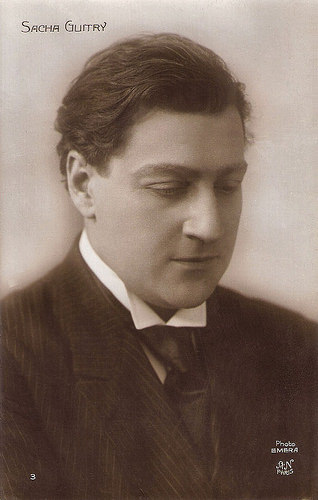
French postcard by A.N., Paris, no. 3. Photo: Emera.
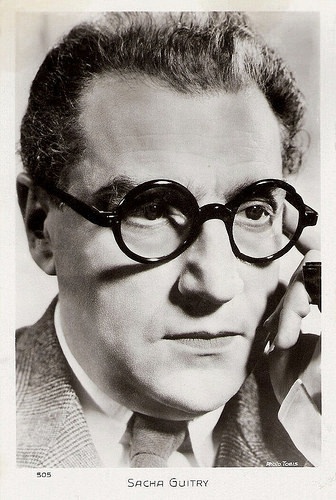
French postcard by Editions Chantal, no. 505. Photo: Tobis.
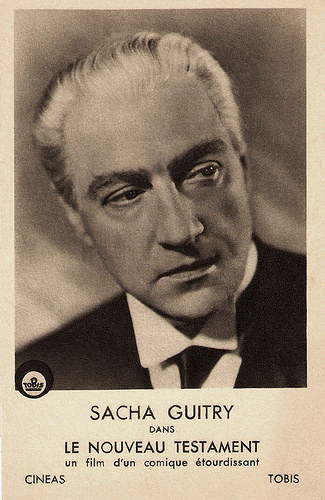
French promotion card by Cineas. Photo: Tobis. Publicity still for Le nouveau Testament/Indiscretions (Sacha Guitry, 1936).
Five consecutive hits
For the next five years Sacha Guitry's plays were, at best, moderate successes. But then he had five consecutive hits with Le Veilleur de nuit (1911), Un Beau mariage (1912), Le Prise de Berg-op-Zoom (1912), La Pèlerine écossaise (1912), and Les Deux converts (1914), the last of which was staged by the Comédie Française.
His first film was Ceux de chez nous/Those of our home (Sacha Guitry, 1915), a short patriotic piece illustrating the works of some French artists like Auguste Renoir, Auguste Rodin and Sarah Bernhardt . He wrote and played in the film Un Roman d'amour et d'aventures (René Hervil, Louis Mercanton, 1917), an experience that left him unsatisfied. He was not greatly attracted by the medium of silent film, regarding dialogue as the essence of drama. So, he did not make a full-length film until 1935.
In 1915 he met the young singer Yvonne Printemps , with whom he began an affair that led Charlotte to leave him and obtain a divorce. Guitry started to write leading roles for Printemps in some musical and others straight comedies. Guitry was reconciled with his father in 1918. Lucien appeared in many productions with his son and Printemps, including Mon Père avait raison and Comment on ecrit l'histoire. They played together not only in Paris, but also in the West End of London.
Guitry developed a charming, witty stage persona, often appearing in period-dress light comedies, for instance his 1925 pastiche Mozart, about the young Wolfgang Amadeus Mozart on a visit to Paris. To compose the score he approached André Messager, with whom he had successfully collaborated in 1923 on a show for Printemps, L'amour masqué. Messager was unavailable and recommended the composer Reynaldo Hahn, who accepted the commission.
The resulting production took some liberties with historical accuracy, but it proved highly popular. Printemps, in a breeches role, played and sang the young Mozart, with Guitry as the composer's patron, Baron Grimm. After playing successfully at the Théâtre Edouard VII, the company presented the piece in London Broadway, Boston and Montreal in 1926-1927.
In 1931 Guitry was awarded the Legion of Honour. In 1932 his marriage to Printemps broke up. He took a six-month break from the theatre, returning in April 1933 in Châteaux en Espagne, which co-starred his new protégée, Jacqueline Delubac , whom he married on his fiftieth birthday.
In 1935 he returned in the film studio to direct and act in Pasteur, a biography of the famous scientific. The film, based on a play Guitry wrote in 1919, was a commercial failure, but during the shooting, Guitry fell in love with the process of filmmaking. He followed Pasteur with Bonne chance (Sacha Guitry, 1936), a comedy written directly for the screen.
In 1936 alone, Guitry released no less than four film, including the screen versions of two of his best known plays: Faisons un rêve (written in 1916), and Mon Père avait raison (written in 1919). Le Roman d'un tricheur/The Story of a Cheat (Sacha Guitry, 1936) was adapted from Guitry's only novel, Les Mémoires d'un tricheur, published in 1935. Despite lukewarm reviews, the film was well received by the public and was also successful abroad. It is now considered his most innovative film.
Apart from the four films, Guitry also wrote five plays in 1936. The following year, he played four roles in the partially historical film Les Perles de la couronne/The Pearls of the Crown (Sacha Guitry, Christian-Jacque, 1937) about the history of seven pearls, four of which end up on the crown of England, the other three end up missing. In 1939, Jacqueline Delubac left her ‘workaholic’ husband. Within months of her leaving him he married for a fourth time; his new wife was actress Geneviève de Séréville.
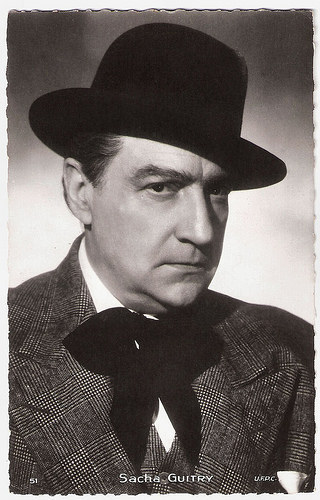
French postcard by Editions E.C., Paris, no. 51. Photo: U.F.P.C.
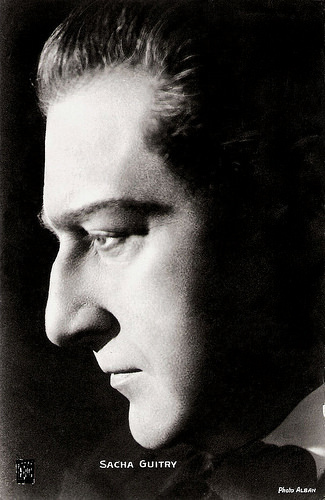
French postcard by Editions et Publications Cinematographiques (EPC), no. 144. Photo: Alban.
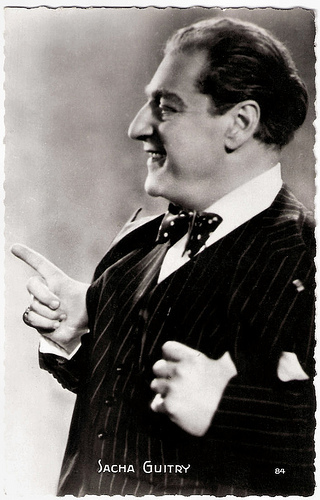
French postcard by Editions P.I., Paris, no. 84.
Accusations of collaborating with the enemy
Sacha Guitry's career was affected by the Nazi occupation of France. He continued to work both on stage and in the cinema under the Nazis. Although this gave him the opportunity to help many of his compatriots it also brought accusations of collaborating with the enemy. He conceived his book and associated film, De 1429 à 1942 ou De Jeanne d'Arc à Philippe Pétain/1429 to 1942, or Joan of Arc to Philippe Pétain (1942) as a tribute to France's past glories, but many saw it as honouring the collaborationist president of Vichy France, Marshal Pétain.
In 1944 Guitry's fourth wife left him. On the liberation of France, Guitry was among the first arrested, by a self-appointed militia. He was interned in a detention camp at Drancy, and suffered ill-effects on his health that necessitated his transfer to a Paris nursing home. He was completely cleared of all accusations of collaboration, but the experience left him disillusioned.
In 1947 Guitry married for the fifth and last time; he was sixty-two and his bride, Lana Marconi, was twenty-eight. He was permitted to resume working in the theatre in 1948, when he returned to the Paris stage with Le Diable boiteux. For the London season in 1953, celebrating the coronation of Elizabeth II, Guitry starred at the Winter Garden in Ecoutez bien, messieurs, a comedy in which he played a voluble Frenchman reduced to baffled silence by an even more voluble Englishwoman, played (in English) by Heather Thatcher. Later in the same year he made his last stage appearance in Paris in Palsambleu.
A huge success in the cinema was the historical drama Si Versailles m'était conté/Royal Affairs in Versailles (Sacha Guitry, 1954) which tells some episodes through portrayal of the personalities who lived in Versailles' castle. In the film appeared a great number of well-known French actors, often in short parts. Guitry also made the ‘sister’ films Napoléon (Sacha Guitry, 1955) with Daniel Gélin as Napoléon as a young man and Raymond Pellegrin as Napoléon in later life, and Si Paris nous était conté/If Paris Were Told to Us (Sacha Guitry, 1956).
He continued to make films until 1957, when he suffered a disabling disease of the nervous system. Sacha Guitry died in Paris at the age of seventy-two. Twelve thousand people filed past his coffin, and he was buried, like his father, in the Cimetière de Montmartre, Paris.
Trailer for Les Perles de la couronne/The Pearls of the Crown (Sacha Guitry, Christian-Jacque, 1937). Source: Retrotrailer (YouTube).
Short scene from Si Versailles m'était conté/Royal Affairs in Versailles (Sacha Guitry, 1954) with Jean Marais and Brigitte Bardot . Source: Filmographie de Brigitte Bardot (YouTube).
Sources: (IMDb), Wikipedia, and .

French postcard by F.A., no. 9. Photo: H. Manuel.

French postcard by Editions P.I., Paris, no. 84. Photo: Studio Piaz.
His own definitive interpreter
Alexandre-Pierre Georges ‘Sacha’ Guitry was born at Nevsky Prospect no. 12, Saint Petersburg, Russia, in 1885. He was the third son of the French actor Lucien Guitry and his wife Marie-Louise-Renée née Delmas de Pont-Jest. The couple had eloped, in the face of family disapproval, and were married at St Martin in the Fields, London, in 1882. They then moved to the Russian capital, where Lucien ran the French theatre company, the Théâtre Michel, from 1882 to 1891.
The marriage was brief. Guitry senior was a persistent adulterer, and his wife instituted divorce proceedings in 1888. Two of their sons died in infancy (one in 1883 and the other in 1887); the other surviving son, Jean became an actor and journalist. The family's Russian nurse habitually shortened Alexandre-Pierre's name to the Russian diminutive ‘Sacha’, by which he was known all his life.
The young Sacha made his stage debut in his father's company at the age of five. When Lucien Guitry returned to Paris he lived in a flat in a prestigious spot, overlooking the Place Vendôme and the Rue de la Paix. The young Sacha lived there, and for his schooling he was first sent to the well-known Lycée Janson de Sailly in the fashionable Sixteenth arrondissement. He did not stay long there, and went to a succession of other schools, both secular and religious, before abandoning formal education at the age of sixteen.
After giving up school Guitry embarked on a career as a playwright with a little musical piece called Le Page (1902), with a score by Ludo Ratz. Eighteen months later he joined his father's company at the Théâtre de la Renaissance. At first he appeared under the stage name ‘Lorcey’, but the pseudonym deceived no-one, as the press immediately announced the debutant's real identity. His first role was in L'Escalier, by Maurice Donnay in November 1904.
He fell out with his father over what the latter saw as Guitry's lack of professionalism. In the aftermath of their quarrel they neither saw nor spoke to one another. A member of Lucien Guitry's company was a young actress, Charlotte Lysès. In 1905 she and Sacha set up home together. For her he wrote his play, Le KWTZ (1905).
He had his first substantial hit with Nono at the Mathurins. When the leading man in Guitry's 1906 play Chez les Zoaques fell ill the author took over, and in the words of a critic, "proved to be his own definitive interpreter". The pattern of his career was set: he remained an actor-author, and later manager, for the rest of his life.

French postcard by A.N., Paris, no. 3. Photo: Emera.

French postcard by Editions Chantal, no. 505. Photo: Tobis.

French promotion card by Cineas. Photo: Tobis. Publicity still for Le nouveau Testament/Indiscretions (Sacha Guitry, 1936).
Five consecutive hits
For the next five years Sacha Guitry's plays were, at best, moderate successes. But then he had five consecutive hits with Le Veilleur de nuit (1911), Un Beau mariage (1912), Le Prise de Berg-op-Zoom (1912), La Pèlerine écossaise (1912), and Les Deux converts (1914), the last of which was staged by the Comédie Française.
His first film was Ceux de chez nous/Those of our home (Sacha Guitry, 1915), a short patriotic piece illustrating the works of some French artists like Auguste Renoir, Auguste Rodin and Sarah Bernhardt . He wrote and played in the film Un Roman d'amour et d'aventures (René Hervil, Louis Mercanton, 1917), an experience that left him unsatisfied. He was not greatly attracted by the medium of silent film, regarding dialogue as the essence of drama. So, he did not make a full-length film until 1935.
In 1915 he met the young singer Yvonne Printemps , with whom he began an affair that led Charlotte to leave him and obtain a divorce. Guitry started to write leading roles for Printemps in some musical and others straight comedies. Guitry was reconciled with his father in 1918. Lucien appeared in many productions with his son and Printemps, including Mon Père avait raison and Comment on ecrit l'histoire. They played together not only in Paris, but also in the West End of London.
Guitry developed a charming, witty stage persona, often appearing in period-dress light comedies, for instance his 1925 pastiche Mozart, about the young Wolfgang Amadeus Mozart on a visit to Paris. To compose the score he approached André Messager, with whom he had successfully collaborated in 1923 on a show for Printemps, L'amour masqué. Messager was unavailable and recommended the composer Reynaldo Hahn, who accepted the commission.
The resulting production took some liberties with historical accuracy, but it proved highly popular. Printemps, in a breeches role, played and sang the young Mozart, with Guitry as the composer's patron, Baron Grimm. After playing successfully at the Théâtre Edouard VII, the company presented the piece in London Broadway, Boston and Montreal in 1926-1927.
In 1931 Guitry was awarded the Legion of Honour. In 1932 his marriage to Printemps broke up. He took a six-month break from the theatre, returning in April 1933 in Châteaux en Espagne, which co-starred his new protégée, Jacqueline Delubac , whom he married on his fiftieth birthday.
In 1935 he returned in the film studio to direct and act in Pasteur, a biography of the famous scientific. The film, based on a play Guitry wrote in 1919, was a commercial failure, but during the shooting, Guitry fell in love with the process of filmmaking. He followed Pasteur with Bonne chance (Sacha Guitry, 1936), a comedy written directly for the screen.
In 1936 alone, Guitry released no less than four film, including the screen versions of two of his best known plays: Faisons un rêve (written in 1916), and Mon Père avait raison (written in 1919). Le Roman d'un tricheur/The Story of a Cheat (Sacha Guitry, 1936) was adapted from Guitry's only novel, Les Mémoires d'un tricheur, published in 1935. Despite lukewarm reviews, the film was well received by the public and was also successful abroad. It is now considered his most innovative film.
Apart from the four films, Guitry also wrote five plays in 1936. The following year, he played four roles in the partially historical film Les Perles de la couronne/The Pearls of the Crown (Sacha Guitry, Christian-Jacque, 1937) about the history of seven pearls, four of which end up on the crown of England, the other three end up missing. In 1939, Jacqueline Delubac left her ‘workaholic’ husband. Within months of her leaving him he married for a fourth time; his new wife was actress Geneviève de Séréville.

French postcard by Editions E.C., Paris, no. 51. Photo: U.F.P.C.

French postcard by Editions et Publications Cinematographiques (EPC), no. 144. Photo: Alban.

French postcard by Editions P.I., Paris, no. 84.
Accusations of collaborating with the enemy
Sacha Guitry's career was affected by the Nazi occupation of France. He continued to work both on stage and in the cinema under the Nazis. Although this gave him the opportunity to help many of his compatriots it also brought accusations of collaborating with the enemy. He conceived his book and associated film, De 1429 à 1942 ou De Jeanne d'Arc à Philippe Pétain/1429 to 1942, or Joan of Arc to Philippe Pétain (1942) as a tribute to France's past glories, but many saw it as honouring the collaborationist president of Vichy France, Marshal Pétain.
In 1944 Guitry's fourth wife left him. On the liberation of France, Guitry was among the first arrested, by a self-appointed militia. He was interned in a detention camp at Drancy, and suffered ill-effects on his health that necessitated his transfer to a Paris nursing home. He was completely cleared of all accusations of collaboration, but the experience left him disillusioned.
In 1947 Guitry married for the fifth and last time; he was sixty-two and his bride, Lana Marconi, was twenty-eight. He was permitted to resume working in the theatre in 1948, when he returned to the Paris stage with Le Diable boiteux. For the London season in 1953, celebrating the coronation of Elizabeth II, Guitry starred at the Winter Garden in Ecoutez bien, messieurs, a comedy in which he played a voluble Frenchman reduced to baffled silence by an even more voluble Englishwoman, played (in English) by Heather Thatcher. Later in the same year he made his last stage appearance in Paris in Palsambleu.
A huge success in the cinema was the historical drama Si Versailles m'était conté/Royal Affairs in Versailles (Sacha Guitry, 1954) which tells some episodes through portrayal of the personalities who lived in Versailles' castle. In the film appeared a great number of well-known French actors, often in short parts. Guitry also made the ‘sister’ films Napoléon (Sacha Guitry, 1955) with Daniel Gélin as Napoléon as a young man and Raymond Pellegrin as Napoléon in later life, and Si Paris nous était conté/If Paris Were Told to Us (Sacha Guitry, 1956).
He continued to make films until 1957, when he suffered a disabling disease of the nervous system. Sacha Guitry died in Paris at the age of seventy-two. Twelve thousand people filed past his coffin, and he was buried, like his father, in the Cimetière de Montmartre, Paris.
Trailer for Les Perles de la couronne/The Pearls of the Crown (Sacha Guitry, Christian-Jacque, 1937). Source: Retrotrailer (YouTube).
Short scene from Si Versailles m'était conté/Royal Affairs in Versailles (Sacha Guitry, 1954) with Jean Marais and Brigitte Bardot . Source: Filmographie de Brigitte Bardot (YouTube).
Sources: (IMDb), Wikipedia, and .
Published on May 17, 2015 22:00
May 16, 2015
Julie Christie
Smart and sexy Julie Christie (1941) is an icon of the new British cinema. During the Swinging Sixties she became a superstar with such roles as Lara in the worldwide smash hit Doctor Zhivago (1965). Since then she has won the Oscar, the Golden Globe, the BAFTA, and the Screen Actors Guild Awards.
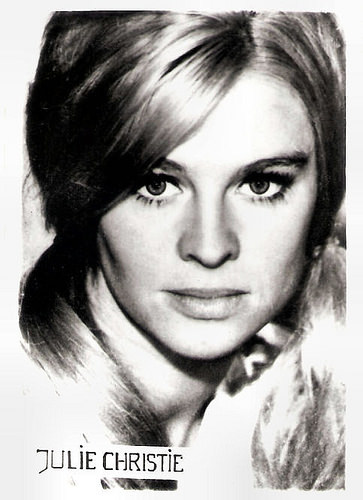
Small Romanian collectors card.
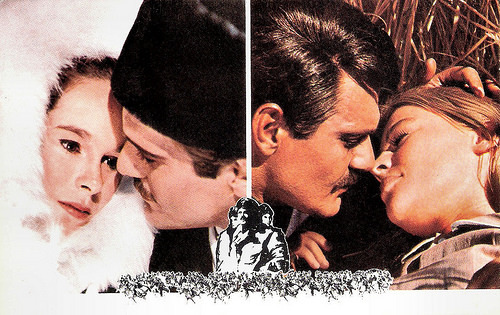
American postcard. Photo: MGM. Photo: publicity stills for Dr. Zhivago (David Lean, 1965) with Geraldine Chaplin, Omar Sharif and Julie Christie.
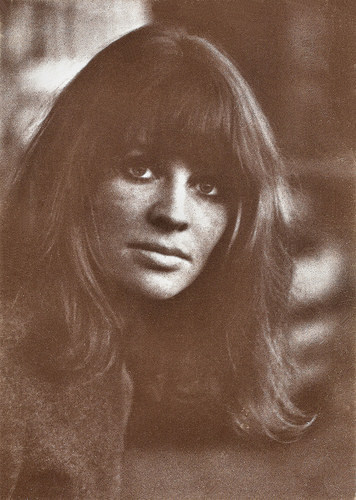
French postcard by Travelling Editions, Paris, no. CP 52. Caption: Julie Christie in 1967.
The It Girl of the Swinging Sixties
Julie Frances Christie was born in 1941 in Chukua, India, then part of the British Empire. She was the daughter of Frank St. John Christie, a tea planter, and his Welsh wife Rosemary (née Ramsden), who was a painter. Her younger brother, Clive Christie, would become a professor of Southeast Asian studies at Hull University. They grew up on their father's tea plantation in Assam.
At 7, Julie was sent to England for her education. As a teenager at Wycombe Court School, she played the role of the Dauphin in a school production of George Bernard Shaw's Saint Joan. A fascination with the artist's lifestyle led to her enrolling in London's Central School of Speech and Drama training.
Christie made her stage debut as a member of the Frinton Repertory of Essex in 1957. One of her first roles was playing Anne Frank in a London theatrical production of The Diary of Anne Frank. Christie was not fond of the stage, even though it allowed her to travel, including a professional gig in the United States. She made her TV debut as an artificially girl created from the DNA of a deceased science lab assistant in the BBC Sci-fi series A for Andromeda (Michael Hayes, 1961).
Her first film appearance was a bit part in the amusing comedy Crooks Anonymous (Ken Annakin, 1962), which was followed up by a larger ingénue role in the romantic comedy The Fast Lady (Ken Annakin, 1963) with Stanley Baker .
Christie first worked with the man who would kick her career into high gear, director John Schlesinger, when he choose her as a replacement for the actress (Topsy Jane) originally cast in Billy Liar (John Schlesinger, 1963). Christie's turn in the film as the free-wheeling Liz, the supremely confident friend and love interest to Tom Courtenay's full-time dreamer Billy, was a stunner, and she had her first taste of becoming an icon of the new British cinema.
Her screen presence was such that the great John Ford cast her as the young prostitute Daisy Battles in Young Cassidy (Jack Cardiff, John Ford, 1965), a biopic about Irish playwright Sean O'Casey.
She made her breakthrough to super-stardom in Schlesinger's seminal Swinging Sixties film Darling (John Schlesinger, 1965). Schlesinger called on Christie to play the role of the manipulative young actress and jet setter Diana Scott when the casting of Shirley MacLaine fell through. As played by Christie, Diana is an amoral social butterfly who undergoes a metamorphosis from immature sex kitten to jaded socialite. For her complex performance, Christie won raves, including the Best Actress Oscar and the Best Actress BAFTA.
Her image as the It Girl of the Swinging Sixties was further cemented by her appearance in the documentary Tonite Let's All Make Love in London (1967), which covered the hipster scene in England.
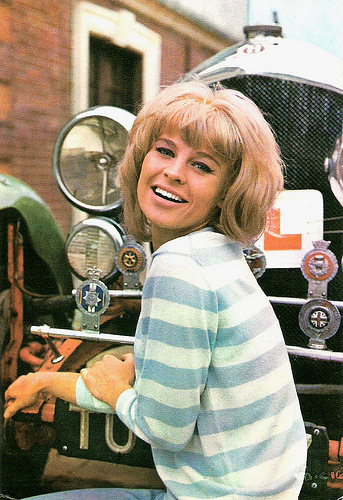
Spanish postcard by Raker, no. 1127. Photo: publicity still for The Fast Lady (1963).
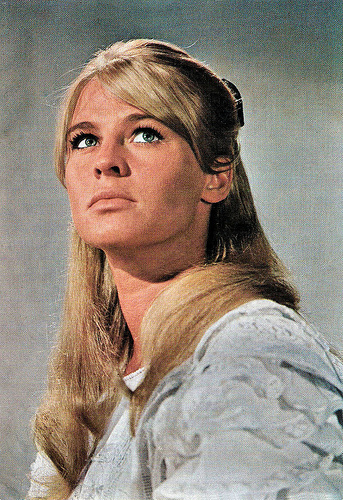
Italian postcard by Rotalcolor, Milano, no. 273.
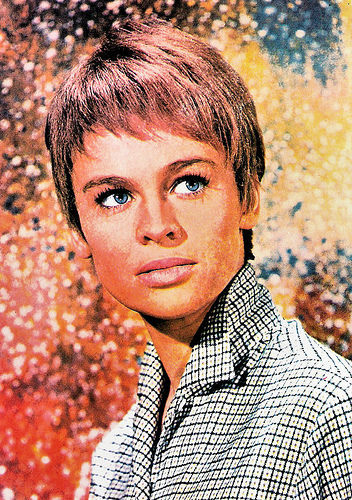
French postcard by E.D.U.G., no. 484. Photo: Atlantic Press.
One of the All-Time Box-Office Champs
Julie Christie followed up Darling (1965) with the role of the tragic Lara Antipova in the two-time Academy Award-winning Doctor Zhivago (David Lean, 1965). Lean’s epic adaptation of Boris Pasternak's novel became one of the all-time box-office champs.
Christie was now a superstar who commanded a price of $400,000 per picture. More interested in film as an art form than in consolidating her movie stardom, Christie followed up Doctor Zhivago (1965) with a dual role in Fahrenheit 451 (1966) for Francois Truffaut, a Nouvelle Vague director she admired. The film was, according to Jon C. Hopwood at IMDb , "hurt by the director's lack of English and by friction between Truffaut and Christie's male co-star Oskar Werner , who had replaced the more-appropriate-for-the-role Terence Stamp ".
Stamp and Christie had been lovers before she had become famous, and he was unsure he could act with her, due to his own ego problems. On his part, Werner resented the attention the smitten Truffaut gave Christie. Stamp overcame those ego problems to sign on as her co-star in John Schlesinger's adaptation of Thomas Hardy's Far from the Madding Crowd (John Schlesinger, 1967), which also starred Peter Finch and Alan Bates .
Jon C. Hopwood at IMDb : “It is a film that is far better remembered now than when it was received in 1967. The film and her performance as the Hardy heroine Bathsheba Everdene was lambasted by film critics, many of whom faulted Christie for being too ‘mod’ and thus untrue to one of Hardy's classic tales of fate.”
She then met the man who transformed her life, undermining her pretensions to a career as a film star in their seven-year-long love affair, the American actor Warren Beatty. Living his life was always far more important than being a star for Beatty, who viewed the movie star profession as a 'treadmill leading to more treadmills' and who was wealthy enough after Bonnie and Clyde (Arthur Penn, 1967) to not have to ever work again. Christie and Beatty had visited a working farm during the production of Far from the Madding Crowd (1967) and had been appalled by the industrial exploitation of the animals. Thereafter, animal rights became a very important subject to Christie. They were kindred souls who remain friends four decades after their affair ended in 1974.
Christie's last box-office hit in which she was the top-liner was Petulia (Richard Lester, 1968), a romantic drama about the romance between a staid doctor (George C. Scott) and a flighty but vulnerable socialite (Christie). According to Jon C. Hopwood it is “a film that featured one of co-star George C. Scott's greatest performances, perfectly counter-balanced by Christie's portrayal of an ‘arch-kook’ who was emblematic of the 1960’s. It is one of the major films of the decade, an underrated masterpiece." Despite the presence of Scott and Shirley Knight, Hopwood claims that the film would not work without Julie Christie. "There is frankly no other actress who could have filled the role, bringing that unique presence and the threat of danger that crackled around Christie's electric aura. At this point of her career, she was poised for greatness as a star, greatness as an actress.”
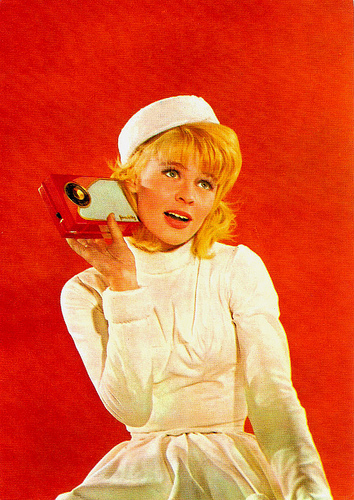
Romanian postcard by Casa Filmului Acin, no. 554.
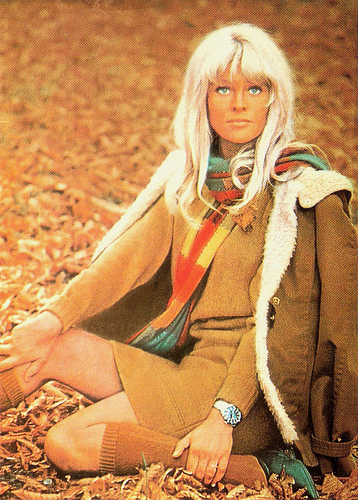
Romanian postcard by Casa Filmului Acin, no. 277.
Dazzling Mystery-Horror Film
After meeting Beatty, Julie Christie essentially surrendered any aspirations to screen stardom, or at maintaining herself as a top-drawer working actress. She turned down the lead in They Shoot Horses, Don't They? (Sydney Pollack, 1969) and Anne of the Thousand Days (Charles Jarrott, 1969), two parts that garnered Oscar nominations for the second choices, Jane Fonda and Geneviève Bujold.
After shooting In Search of Gregory (Peter Wood, 1969), a critical and box office flop, to fulfill her contractual obligations, she spent her time with Beatty in California, renting a beach house at Malibu. She did return to form as the bored upper-class woman who ruins a boy's life by involving him in her sexual duplicities, in The Go-Between (Joseph Losey, 1970), written by playwright Harold Pinter.
She won her second Oscar nomination for her role as a brothel 'madam' in Robert Altman's Western drama McCabe & Mrs. Miller (1971) that she made with her lover Beatty. Christie also turned down the role of the Russian Empress in Nicholas and Alexandra (Franklin J. Schaffner, 1971), another film that won the second-choice (Janet Suzman) a Best Actress Oscar nomination.
Two years later, she appeared in the dazzling mystery-horror film Don't Look Now (Nicolas Roeg, 1973), with its famously erotic love scenes between Christie and Donald Sutherland. Director Nicolas Roeg had been her cinematographer on Fahrenheit 451 (1966), Far from the Madding Crowd (1967) and Petulia (1968).
In the mid-1970s, her affair with Beatty came to an end, but the two remained close friends and worked together in Shampoo (Hal Ashby, 1975) and the comedy Heaven Can Wait (Buck Henry, Warren Beatty, 1978). Christie turned down the part of Louise Bryant in Reds (Warren Beatty, 1981), a part written by Beatty with her in mind, as Christie felt an American should play the role. Beatty's then lover, Diane Keaton, played the part and won a Best Actress Oscar nomination. Other interesting roles she turned down were parts in Rosemary's Baby (Roman Polanski, 1968), The Godfather (Francis Ford Coppola, 1972), Chinatown (Roman Polanski, 1974), Marathon Man (John Schlesinger, 1976), and American Gigolo (Paul Schrader, 1980).
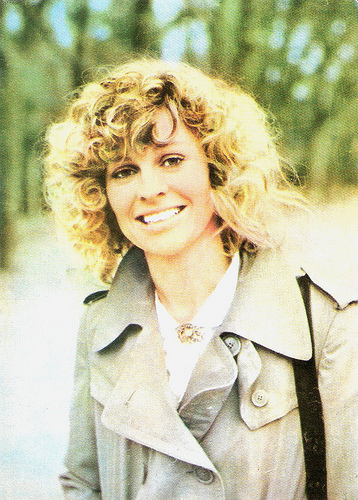
Romanian postcard by Casa Filmului Acin, no. 43 072.
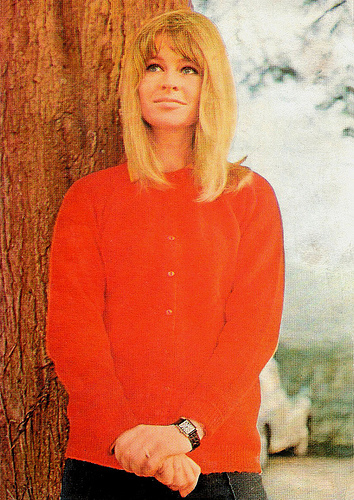
Romanian postcard by Casa Filmului Acin, no. 43 072.
The British Answer to Jane Fonda
Julie Christie moved back to the UK and became 'the British answer to Jane Fonda', campaigning for various social and political causes, including animal rights and nuclear disarmament. She was greatly in demand, but became even more choosy about her roles as her own political awareness increased. Her sporadic film commitments reflected her political consciousness such as the animal rights documentary The Animals Film (Victor Schonfeld, 1981), and the feature The Gold Diggers (Sally Potter, 1983), a feminist reinterpretation of film history.
Roles in The Return of the Soldier (Alan Bridges, 1982) with Alan Bates and Glenda Jackson , and Merchant-Ivory's Heat and Dust (James Ivory, 1983) seemed to herald a return to form, but then she essentially retired.
A career renaissance came in the mid-1990s with her turn as Queen Gertrude in Kenneth Branagh's adaptation of William Shakespeare’s Hamlet (Kenneth Branagh, 1996). More rave notices brought her turn as the faded movie star married to handyman Nick Nolte and romanced by a younger man (Jonny Lee Miller) in Afterglow (Alan Rudolph, 1997). She received her third Best Actress Oscar nomination for her performance, and showed up at the awards as radiant and uniquely beautiful as ever.
Christie lived with left-wing investigative journalist Duncan Campbell (a Manchester Guardian columnist) since 1979, before marrying in 2008. In addition to her film work, she has narrated many books-on-tape. In 1995, she made a triumphant return to the stage in a London revival of Harold Pinter's Old Times, which garnered her superb reviews.
In the decade since Afterglow (1997), she has worked steadily on film in supporting roles. She worked three times with director-screenwriter and actress Sarah Polley: co-starring with Polley in No Such Thing (Hal Hartley, 2001) and the Goya Award-winning La Vida secreta de las palabras/The Secret Life of Words (Isabel Coixet, 2005), and taking the lead in Polley's first feature film as a director, Away from Her (Sarah Polley, 2006).
Christie made a brief appearance in the third Harry Potter film, Harry Potter and the Prisoner of Azkaban (Alfonso Cuarón, 2004), playing Madam Rosmerta, the landlady of the Three Broomsticks pub. That same year, she also appeared in two other high-profile films: Wolfgang Petersen's historical epic Troy (2004) and Marc Forster's Finding Neverland (2004), playing Kate Winslet 's mother. The latter performance earned Christie a BAFTA nomination as supporting actress in film.
In 2008, Christie narrated Uncontacted Tribes, a short film for the British-based charity Survival International, featuring previously unseen footage of remote and endangered peoples. She has been a long-standing supporter of the charity, and in February 2008, was named as its first 'Ambassador'. She appeared in a segment of the anthology film New York, I Love You (2008), written by Anthony Minghella, directed by Shekhar Kapur and co-starring Shia LaBeouf. She also played in Glorious 39 (Stephen Poliakoff, 2008), about a British family at the start of World War II.
In 2011, Christie played a 'sexy, bohemian' version of the grandmother role in a gothic retelling of Red Riding Hood (Catherine Hardwicke, 2011) with Amanda Seyfried in the title role. Her most recent role was in the political thriller The Company You Keep (Robert Redford, 2012), where she co-starred with Robert Redford.
And we conclude this bio with an observation of Brian McFarlane in The Encyclopedia of British Cinema : “Arguably the most genuinely glamorous, and one of the most intelligent, of all British stars, Julie Christie brought a gust of new, sensual life into British cinema.”
>
Trailer for Doctor Zhivago (1965). Source: ccoruja (YouTube).
Trailer of Petulia (1968). Source: the grumpy monk (YouTube).
Trailer Shampoo (1975). Source: Video Detective (YouTube).
Trailer for Away From Her (2006). Source: Lion's Gate (YouTube).
Sources: (IMDb), Brian McFarlane (Encyclopedia of British Cinema), TCM, Wikipedia, and .

Small Romanian collectors card.

American postcard. Photo: MGM. Photo: publicity stills for Dr. Zhivago (David Lean, 1965) with Geraldine Chaplin, Omar Sharif and Julie Christie.

French postcard by Travelling Editions, Paris, no. CP 52. Caption: Julie Christie in 1967.
The It Girl of the Swinging Sixties
Julie Frances Christie was born in 1941 in Chukua, India, then part of the British Empire. She was the daughter of Frank St. John Christie, a tea planter, and his Welsh wife Rosemary (née Ramsden), who was a painter. Her younger brother, Clive Christie, would become a professor of Southeast Asian studies at Hull University. They grew up on their father's tea plantation in Assam.
At 7, Julie was sent to England for her education. As a teenager at Wycombe Court School, she played the role of the Dauphin in a school production of George Bernard Shaw's Saint Joan. A fascination with the artist's lifestyle led to her enrolling in London's Central School of Speech and Drama training.
Christie made her stage debut as a member of the Frinton Repertory of Essex in 1957. One of her first roles was playing Anne Frank in a London theatrical production of The Diary of Anne Frank. Christie was not fond of the stage, even though it allowed her to travel, including a professional gig in the United States. She made her TV debut as an artificially girl created from the DNA of a deceased science lab assistant in the BBC Sci-fi series A for Andromeda (Michael Hayes, 1961).
Her first film appearance was a bit part in the amusing comedy Crooks Anonymous (Ken Annakin, 1962), which was followed up by a larger ingénue role in the romantic comedy The Fast Lady (Ken Annakin, 1963) with Stanley Baker .
Christie first worked with the man who would kick her career into high gear, director John Schlesinger, when he choose her as a replacement for the actress (Topsy Jane) originally cast in Billy Liar (John Schlesinger, 1963). Christie's turn in the film as the free-wheeling Liz, the supremely confident friend and love interest to Tom Courtenay's full-time dreamer Billy, was a stunner, and she had her first taste of becoming an icon of the new British cinema.
Her screen presence was such that the great John Ford cast her as the young prostitute Daisy Battles in Young Cassidy (Jack Cardiff, John Ford, 1965), a biopic about Irish playwright Sean O'Casey.
She made her breakthrough to super-stardom in Schlesinger's seminal Swinging Sixties film Darling (John Schlesinger, 1965). Schlesinger called on Christie to play the role of the manipulative young actress and jet setter Diana Scott when the casting of Shirley MacLaine fell through. As played by Christie, Diana is an amoral social butterfly who undergoes a metamorphosis from immature sex kitten to jaded socialite. For her complex performance, Christie won raves, including the Best Actress Oscar and the Best Actress BAFTA.
Her image as the It Girl of the Swinging Sixties was further cemented by her appearance in the documentary Tonite Let's All Make Love in London (1967), which covered the hipster scene in England.

Spanish postcard by Raker, no. 1127. Photo: publicity still for The Fast Lady (1963).

Italian postcard by Rotalcolor, Milano, no. 273.

French postcard by E.D.U.G., no. 484. Photo: Atlantic Press.
One of the All-Time Box-Office Champs
Julie Christie followed up Darling (1965) with the role of the tragic Lara Antipova in the two-time Academy Award-winning Doctor Zhivago (David Lean, 1965). Lean’s epic adaptation of Boris Pasternak's novel became one of the all-time box-office champs.
Christie was now a superstar who commanded a price of $400,000 per picture. More interested in film as an art form than in consolidating her movie stardom, Christie followed up Doctor Zhivago (1965) with a dual role in Fahrenheit 451 (1966) for Francois Truffaut, a Nouvelle Vague director she admired. The film was, according to Jon C. Hopwood at IMDb , "hurt by the director's lack of English and by friction between Truffaut and Christie's male co-star Oskar Werner , who had replaced the more-appropriate-for-the-role Terence Stamp ".
Stamp and Christie had been lovers before she had become famous, and he was unsure he could act with her, due to his own ego problems. On his part, Werner resented the attention the smitten Truffaut gave Christie. Stamp overcame those ego problems to sign on as her co-star in John Schlesinger's adaptation of Thomas Hardy's Far from the Madding Crowd (John Schlesinger, 1967), which also starred Peter Finch and Alan Bates .
Jon C. Hopwood at IMDb : “It is a film that is far better remembered now than when it was received in 1967. The film and her performance as the Hardy heroine Bathsheba Everdene was lambasted by film critics, many of whom faulted Christie for being too ‘mod’ and thus untrue to one of Hardy's classic tales of fate.”
She then met the man who transformed her life, undermining her pretensions to a career as a film star in their seven-year-long love affair, the American actor Warren Beatty. Living his life was always far more important than being a star for Beatty, who viewed the movie star profession as a 'treadmill leading to more treadmills' and who was wealthy enough after Bonnie and Clyde (Arthur Penn, 1967) to not have to ever work again. Christie and Beatty had visited a working farm during the production of Far from the Madding Crowd (1967) and had been appalled by the industrial exploitation of the animals. Thereafter, animal rights became a very important subject to Christie. They were kindred souls who remain friends four decades after their affair ended in 1974.
Christie's last box-office hit in which she was the top-liner was Petulia (Richard Lester, 1968), a romantic drama about the romance between a staid doctor (George C. Scott) and a flighty but vulnerable socialite (Christie). According to Jon C. Hopwood it is “a film that featured one of co-star George C. Scott's greatest performances, perfectly counter-balanced by Christie's portrayal of an ‘arch-kook’ who was emblematic of the 1960’s. It is one of the major films of the decade, an underrated masterpiece." Despite the presence of Scott and Shirley Knight, Hopwood claims that the film would not work without Julie Christie. "There is frankly no other actress who could have filled the role, bringing that unique presence and the threat of danger that crackled around Christie's electric aura. At this point of her career, she was poised for greatness as a star, greatness as an actress.”

Romanian postcard by Casa Filmului Acin, no. 554.

Romanian postcard by Casa Filmului Acin, no. 277.
Dazzling Mystery-Horror Film
After meeting Beatty, Julie Christie essentially surrendered any aspirations to screen stardom, or at maintaining herself as a top-drawer working actress. She turned down the lead in They Shoot Horses, Don't They? (Sydney Pollack, 1969) and Anne of the Thousand Days (Charles Jarrott, 1969), two parts that garnered Oscar nominations for the second choices, Jane Fonda and Geneviève Bujold.
After shooting In Search of Gregory (Peter Wood, 1969), a critical and box office flop, to fulfill her contractual obligations, she spent her time with Beatty in California, renting a beach house at Malibu. She did return to form as the bored upper-class woman who ruins a boy's life by involving him in her sexual duplicities, in The Go-Between (Joseph Losey, 1970), written by playwright Harold Pinter.
She won her second Oscar nomination for her role as a brothel 'madam' in Robert Altman's Western drama McCabe & Mrs. Miller (1971) that she made with her lover Beatty. Christie also turned down the role of the Russian Empress in Nicholas and Alexandra (Franklin J. Schaffner, 1971), another film that won the second-choice (Janet Suzman) a Best Actress Oscar nomination.
Two years later, she appeared in the dazzling mystery-horror film Don't Look Now (Nicolas Roeg, 1973), with its famously erotic love scenes between Christie and Donald Sutherland. Director Nicolas Roeg had been her cinematographer on Fahrenheit 451 (1966), Far from the Madding Crowd (1967) and Petulia (1968).
In the mid-1970s, her affair with Beatty came to an end, but the two remained close friends and worked together in Shampoo (Hal Ashby, 1975) and the comedy Heaven Can Wait (Buck Henry, Warren Beatty, 1978). Christie turned down the part of Louise Bryant in Reds (Warren Beatty, 1981), a part written by Beatty with her in mind, as Christie felt an American should play the role. Beatty's then lover, Diane Keaton, played the part and won a Best Actress Oscar nomination. Other interesting roles she turned down were parts in Rosemary's Baby (Roman Polanski, 1968), The Godfather (Francis Ford Coppola, 1972), Chinatown (Roman Polanski, 1974), Marathon Man (John Schlesinger, 1976), and American Gigolo (Paul Schrader, 1980).

Romanian postcard by Casa Filmului Acin, no. 43 072.

Romanian postcard by Casa Filmului Acin, no. 43 072.
The British Answer to Jane Fonda
Julie Christie moved back to the UK and became 'the British answer to Jane Fonda', campaigning for various social and political causes, including animal rights and nuclear disarmament. She was greatly in demand, but became even more choosy about her roles as her own political awareness increased. Her sporadic film commitments reflected her political consciousness such as the animal rights documentary The Animals Film (Victor Schonfeld, 1981), and the feature The Gold Diggers (Sally Potter, 1983), a feminist reinterpretation of film history.
Roles in The Return of the Soldier (Alan Bridges, 1982) with Alan Bates and Glenda Jackson , and Merchant-Ivory's Heat and Dust (James Ivory, 1983) seemed to herald a return to form, but then she essentially retired.
A career renaissance came in the mid-1990s with her turn as Queen Gertrude in Kenneth Branagh's adaptation of William Shakespeare’s Hamlet (Kenneth Branagh, 1996). More rave notices brought her turn as the faded movie star married to handyman Nick Nolte and romanced by a younger man (Jonny Lee Miller) in Afterglow (Alan Rudolph, 1997). She received her third Best Actress Oscar nomination for her performance, and showed up at the awards as radiant and uniquely beautiful as ever.
Christie lived with left-wing investigative journalist Duncan Campbell (a Manchester Guardian columnist) since 1979, before marrying in 2008. In addition to her film work, she has narrated many books-on-tape. In 1995, she made a triumphant return to the stage in a London revival of Harold Pinter's Old Times, which garnered her superb reviews.
In the decade since Afterglow (1997), she has worked steadily on film in supporting roles. She worked three times with director-screenwriter and actress Sarah Polley: co-starring with Polley in No Such Thing (Hal Hartley, 2001) and the Goya Award-winning La Vida secreta de las palabras/The Secret Life of Words (Isabel Coixet, 2005), and taking the lead in Polley's first feature film as a director, Away from Her (Sarah Polley, 2006).
Christie made a brief appearance in the third Harry Potter film, Harry Potter and the Prisoner of Azkaban (Alfonso Cuarón, 2004), playing Madam Rosmerta, the landlady of the Three Broomsticks pub. That same year, she also appeared in two other high-profile films: Wolfgang Petersen's historical epic Troy (2004) and Marc Forster's Finding Neverland (2004), playing Kate Winslet 's mother. The latter performance earned Christie a BAFTA nomination as supporting actress in film.
In 2008, Christie narrated Uncontacted Tribes, a short film for the British-based charity Survival International, featuring previously unseen footage of remote and endangered peoples. She has been a long-standing supporter of the charity, and in February 2008, was named as its first 'Ambassador'. She appeared in a segment of the anthology film New York, I Love You (2008), written by Anthony Minghella, directed by Shekhar Kapur and co-starring Shia LaBeouf. She also played in Glorious 39 (Stephen Poliakoff, 2008), about a British family at the start of World War II.
In 2011, Christie played a 'sexy, bohemian' version of the grandmother role in a gothic retelling of Red Riding Hood (Catherine Hardwicke, 2011) with Amanda Seyfried in the title role. Her most recent role was in the political thriller The Company You Keep (Robert Redford, 2012), where she co-starred with Robert Redford.
And we conclude this bio with an observation of Brian McFarlane in The Encyclopedia of British Cinema : “Arguably the most genuinely glamorous, and one of the most intelligent, of all British stars, Julie Christie brought a gust of new, sensual life into British cinema.”
>
Trailer for Doctor Zhivago (1965). Source: ccoruja (YouTube).
Trailer of Petulia (1968). Source: the grumpy monk (YouTube).
Trailer Shampoo (1975). Source: Video Detective (YouTube).
Trailer for Away From Her (2006). Source: Lion's Gate (YouTube).
Sources: (IMDb), Brian McFarlane (Encyclopedia of British Cinema), TCM, Wikipedia, and .
Published on May 16, 2015 22:00
May 15, 2015
Ich hab mein Herz in Heidelberg verloren... (1926)
Ich hab mein Herz in Heidelberg verloren.../I Lost My Heart in Heidelberg (1926) was a German silent comedy directed by Arthur Bergen. It was produced by the Münchner Lichtspielkunst AG (Emelka), one of the few German film studios which was not located in Berlin but in Munich. The young lovers were played by Werner Fuetterer and Dorothea Wieck, both at the start of a promising career.
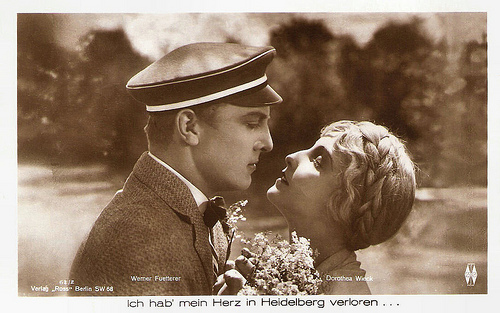
German postcard by Ross Verlag, Berlin, no. 61/2, 1926. Photo: Münchner Lichtspielkunst AG (Emelka). Publicity still for Ich hab mein Herz in Heidelberg verloren/I Lost My Heart in Heidelberg (Arthur Bergen, 1926).
An immediate popular hit
Ich hab' mein Herz in Heidelberg verloren took its title from a German song composed in 1925 by Fred Raymond with lyrics by Fritz Löhner-Beda and Ernst Neubach. The song was an immediate popular hit, and in 1927 Raymond included it in a musical of the same name.
The refrain goes:
"Ich hab' mein Herz in Heidelberg verloren,
In einer lauen Sommernacht.
Ich war verliebt bis über beide Ohren
Und wie ein Röslein hat ihr Mund gelacht.
Und als wir Abschied nahmen vor den Toren
Beim letzten Kuß, da hab ich's klar erkannt:
Daß ich mein Herz in Heidelberg verloren.
Mein Herz, es schlägt am Neckarstrand."
"I lost my heart in Heidelberg
on a warm summer night.
I was in love head over heels
and like a rosebud her lips laughed
And as we bid farewell at the gates
during the last kiss
I knew clearly right there
that I lost my heart in Heidelberg
My heart beats on the beach of Neckar!"
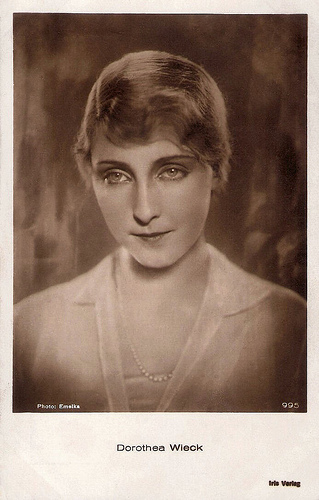
Dorothea Wieck . Austrian postcard by Iris Verlag, no. 995. Photo: Emelka.
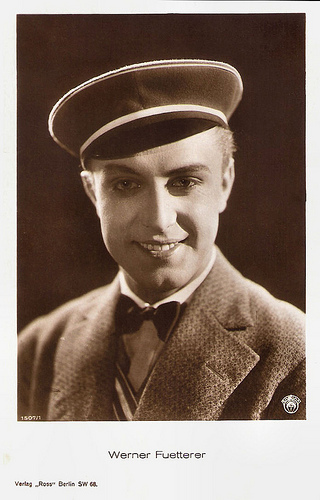
Werner Fuetterer . German postcard by Ross Verlag, Berlin, no. 1507/1, 1927-1928. Photo: Münchner Lichtspielkunst AG (Emelka). Publicity still for Ich hab mein Herz in Heidelberg verloren/I Lost My Heart in Heidelberg (Arthur Bergen, 1926).
Sequel and remake
The film Ich hab mein Herz in Heidelberg verloren (1926) was directed by Arthur Bergen, and written by German playwright Max Ferner. Arthur Bergen was an Austrian actor-director, active in the film industry since 1915. Max Ferner was the screenplay co-writer for what would later become Alfred Hitchcock's film The Mountain Eagle (1927).
The cast of Ich hab mein Herz in Heidelberg verloren (1926) included apart from Werner Fuetterer and Dorothea Wieck also Emil Höfer, Gertrud de Lalsky, Mary Parker and Harry Halm . The production company was Emelka or Münchner Lichtspielkunst AG, a Munich based film studio which was active from 1919 till 1932. The company was a direct competitor to UFA, which had started in Berlin in 1917, and quickly absorbed several other film industry companies in the region.
In 1930 investor Wilhelm Kraus and a consortium of banks bought a major shareholding in Emelka, and on 21 September 1932 the group took control of the company and renamed it Bavaria Film AG. In 1938 the Bavaria Film was nationalised but privatised again in 1956. Bavaria is still one of Europe's largest film production companies, with some 30 subsidiaries.
Emelka produced a sequel to Ich hab mein Herz in Heidelberg verloren (1926), Mein Heidelberg, ich kann Dich nicht vergessen/My Heidelberg, I can't forget you (James Bauer, 1927). Many in the cast returned but instead of Fuetterer and Parker now Hans Adalbert Schlettow and Vivian Gibson joined the cast.
After the Second World War, another film took its title from the song: the West German romantic musical Ich hab' mein Herz in Heidelberg verloren/I Lost My Heart in Heidelberg (Ernst Neubach, 1952).
The film starred Eva Probst and Adrian Hoven as the young lovers and Paul Hörbiger . It premiered in Heidelberg on 29 October 1952. This musical was part of a strong trend towards Heimatfilms set in romanticised Southern Germany, Austria or Switzerland.
The song Ich hab' mein Herz in Heidelberg verloren has become an evergreen and remains the theme song of the city of Heidelberg.
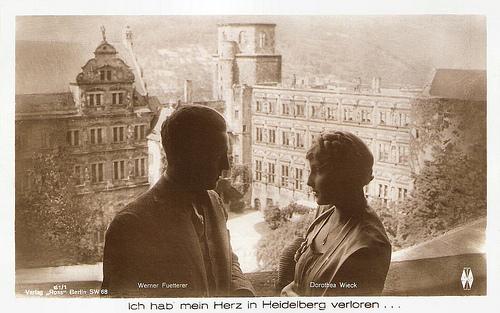
German postcard by Ross Verlag, Berlin, no. 61/1, 1926. Photo: Münchner Lichtspielkunst AG (Emelka). Publicity still for Ich hab mein Herz in Heidelberg verloren/I Lost My Heart in Heidelberg (Arthur Bergen, 1926).
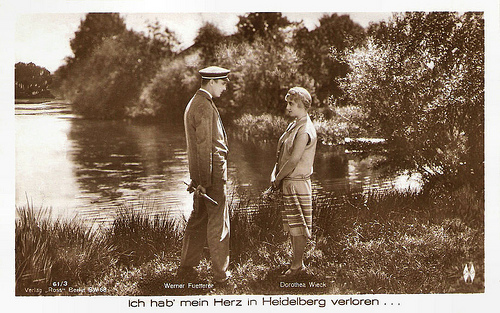
German postcard by Ross Verlag, Berlin, no. 61/3, 1926. Photo: Münchner Lichtspielkunst AG (Emelka). Publicity still for Ich hab mein Herz in Heidelberg verloren/I Lost My Heart in Heidelberg (Arthur Bergen, 1926).
Sources: Cuppachino, Wikipedia and IMDb.
Hear the song.

German postcard by Ross Verlag, Berlin, no. 61/2, 1926. Photo: Münchner Lichtspielkunst AG (Emelka). Publicity still for Ich hab mein Herz in Heidelberg verloren/I Lost My Heart in Heidelberg (Arthur Bergen, 1926).
An immediate popular hit
Ich hab' mein Herz in Heidelberg verloren took its title from a German song composed in 1925 by Fred Raymond with lyrics by Fritz Löhner-Beda and Ernst Neubach. The song was an immediate popular hit, and in 1927 Raymond included it in a musical of the same name.
The refrain goes:
"Ich hab' mein Herz in Heidelberg verloren,
In einer lauen Sommernacht.
Ich war verliebt bis über beide Ohren
Und wie ein Röslein hat ihr Mund gelacht.
Und als wir Abschied nahmen vor den Toren
Beim letzten Kuß, da hab ich's klar erkannt:
Daß ich mein Herz in Heidelberg verloren.
Mein Herz, es schlägt am Neckarstrand."
"I lost my heart in Heidelberg
on a warm summer night.
I was in love head over heels
and like a rosebud her lips laughed
And as we bid farewell at the gates
during the last kiss
I knew clearly right there
that I lost my heart in Heidelberg
My heart beats on the beach of Neckar!"

Dorothea Wieck . Austrian postcard by Iris Verlag, no. 995. Photo: Emelka.

Werner Fuetterer . German postcard by Ross Verlag, Berlin, no. 1507/1, 1927-1928. Photo: Münchner Lichtspielkunst AG (Emelka). Publicity still for Ich hab mein Herz in Heidelberg verloren/I Lost My Heart in Heidelberg (Arthur Bergen, 1926).
Sequel and remake
The film Ich hab mein Herz in Heidelberg verloren (1926) was directed by Arthur Bergen, and written by German playwright Max Ferner. Arthur Bergen was an Austrian actor-director, active in the film industry since 1915. Max Ferner was the screenplay co-writer for what would later become Alfred Hitchcock's film The Mountain Eagle (1927).
The cast of Ich hab mein Herz in Heidelberg verloren (1926) included apart from Werner Fuetterer and Dorothea Wieck also Emil Höfer, Gertrud de Lalsky, Mary Parker and Harry Halm . The production company was Emelka or Münchner Lichtspielkunst AG, a Munich based film studio which was active from 1919 till 1932. The company was a direct competitor to UFA, which had started in Berlin in 1917, and quickly absorbed several other film industry companies in the region.
In 1930 investor Wilhelm Kraus and a consortium of banks bought a major shareholding in Emelka, and on 21 September 1932 the group took control of the company and renamed it Bavaria Film AG. In 1938 the Bavaria Film was nationalised but privatised again in 1956. Bavaria is still one of Europe's largest film production companies, with some 30 subsidiaries.
Emelka produced a sequel to Ich hab mein Herz in Heidelberg verloren (1926), Mein Heidelberg, ich kann Dich nicht vergessen/My Heidelberg, I can't forget you (James Bauer, 1927). Many in the cast returned but instead of Fuetterer and Parker now Hans Adalbert Schlettow and Vivian Gibson joined the cast.
After the Second World War, another film took its title from the song: the West German romantic musical Ich hab' mein Herz in Heidelberg verloren/I Lost My Heart in Heidelberg (Ernst Neubach, 1952).
The film starred Eva Probst and Adrian Hoven as the young lovers and Paul Hörbiger . It premiered in Heidelberg on 29 October 1952. This musical was part of a strong trend towards Heimatfilms set in romanticised Southern Germany, Austria or Switzerland.
The song Ich hab' mein Herz in Heidelberg verloren has become an evergreen and remains the theme song of the city of Heidelberg.

German postcard by Ross Verlag, Berlin, no. 61/1, 1926. Photo: Münchner Lichtspielkunst AG (Emelka). Publicity still for Ich hab mein Herz in Heidelberg verloren/I Lost My Heart in Heidelberg (Arthur Bergen, 1926).

German postcard by Ross Verlag, Berlin, no. 61/3, 1926. Photo: Münchner Lichtspielkunst AG (Emelka). Publicity still for Ich hab mein Herz in Heidelberg verloren/I Lost My Heart in Heidelberg (Arthur Bergen, 1926).
Sources: Cuppachino, Wikipedia and IMDb.
Hear the song.
Published on May 15, 2015 22:00
May 14, 2015
Daniel Martín
Spanish actor Daniel Martín (1935-2009) acted in more than 60 European films, including Sergio Leone's classic Spaghetti Western Per un pugno di dollari/A Fistful of Dollars (1964). Under the pseudonym Dan Martin, he played Unkas, the son of the chief of the Mohicans, in the Eurowestern Der Letze Mohikaner/The Last Tomahawk (1965), based on the famous novel The Last of the Mohicans by James Fenimore Cooper.
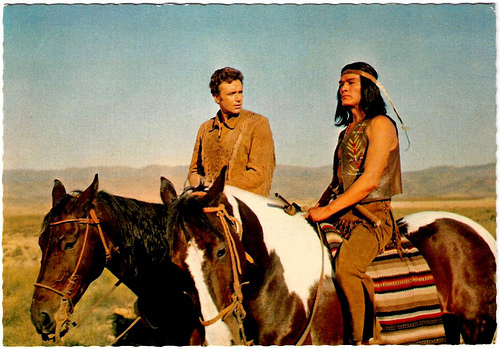
German postcard, no. 1 of 64. Photo by Constantin. Still for Der Letze Mohikaner (1965) with Anthony Steffen .
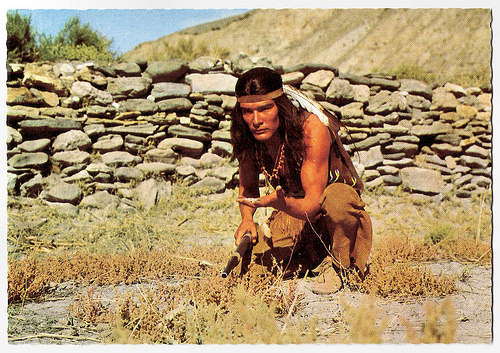
German postcard, no. 53 of 64. Photo: Constantin. Still from Der Lezte Mohikaner/The Last Tomahawk (1965). Caption: Trotz des Kampfgetümmels ist Unkas das Vorgehen seines Feindes Magua nicht entgangen. Er kämpft sich frei und nimmt Maguas Spur auf. (Despite the battle tumult, Unkas did not fail to notice the actions of his enemy Magua. He fights his way free and takes Maguas track.)
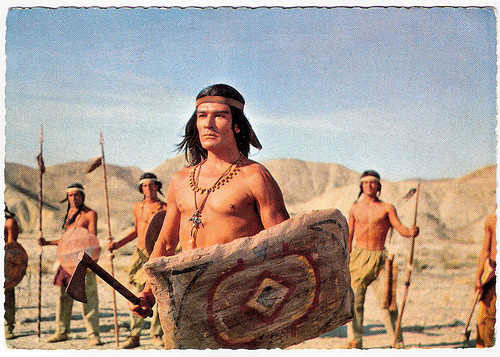
German postcard, no. 58 of 64. Photo: Constantin. Still from Der Lezte Mohikaner/The Last Tomahawk (1964). Caption: "Der weise Häuptling hat beide gehört. Er befragt darauf den grossen Manitu. Das Gottesurteil lautet: Ein Zweikampf soll über Leben und Tod entscheiden." (The wise chief has heard both. He asked it the great Manitou. The judgment of the God is: a duel will decide about life and death.)
Excellent Spaghetti Western
Daniel Martin was born José Daniel Martínez Martínez in Cartagena, Spain in 1935. In 1962 he made his film debut in the historical drama La spada del Cid/The Sword of El Cid (Miguel Ilglesias, 1962).
Since this debut Martín played supporting roles and small parts in over 60 films, including many exploitation movies. He also appeared in such interesting productions as the Oscar nominated romance Los Tarantos (Francisco Rovira Beleta, 1963) with Antonio Gades, and the classic Spaghetti Western Per un pugno di dollari/A Fistful of Dollars (Sergio Leone, 1964) starring Clint Eastwood .
Other film, he appeared in were the heist caper Las Vegas, 500 millones/They Came to Rob Las Vegas (Antonio Isasi-Isasmendi, 1968), the excellent Spaghetti Western Anda muchacho, spara!/At the End of the Rainbow (Aldo Florio, 1971) with Fabio Testi, and the thriller La polizia incrimina la legge assolve/High Crime (Enzo G. Castellari, 1973) with Fernando Rey.
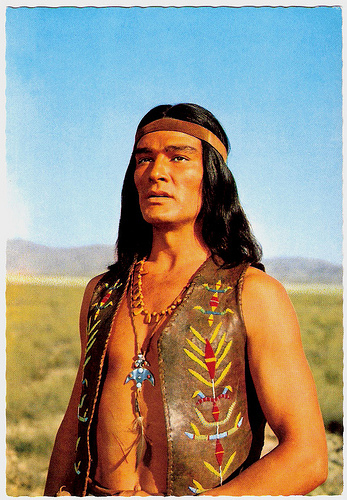
German postcard, no. 56 of 64. Photo: Constantin. Still from Der Lezte Mohikaner/The Last Tomahawk (1965).
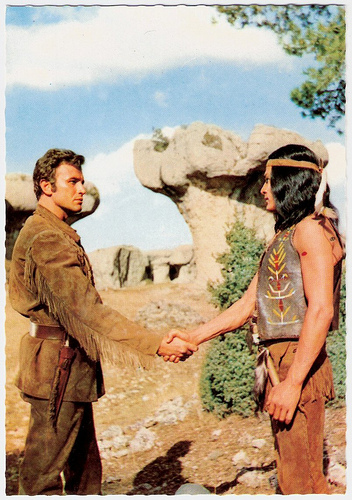
German postcard, no. 4 of 64. Photo: Constantin. Still from Der Lezte Mohikaner (1965) with Anthony Steffen .
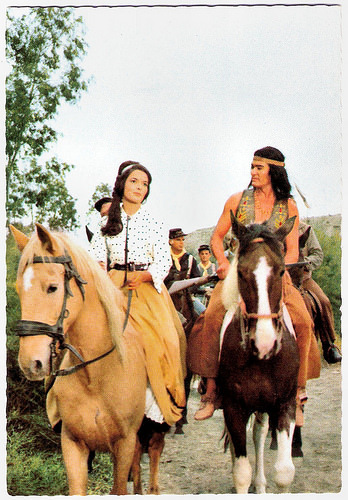
German postcard, no. 36 of 64. Photo: Constantin. Still from Der Lezte Mohikaner/The Last of the Mohicans (Harald Reinl, 1965) with Karin Dor .
The Last of the Mohicans
Under the pseudonym Dan Martin, Daniel Martín starred in Der Letze Mohikaner/The Last of the Mohicans (Harald Reinl, 1965). This Euro-western was based on the historical novel The Last of the Mohicans by James Fenimore Cooper, first published in 1826.
The story takes place in 1757, during the French and Indian War (the Seven Years' War), when France and Great Britain battled for control of the North American colonies. During this war, the French called on allied Native American tribes to fight against the more numerous British colonists.
Daniel Martín played Uncas, the son of the chief of the Mohicans. Uncas rides with his white ally, the frontiersman Natty Bumppo, known as Falkenauge/Hawkeye ( Anthony Steffen ) through the country. Soon they discover that the Huron and a gang of white bandits have destroyed the tribe of the Mohicans...
After Der Letze Mohikaner Martín also starred as Uncas in the sequel, Uncas, el fin de una raza/Fall of the Mohicans (Mateo Cano, 1965), but this time without Anthony Steffen . In 1970 both actors starred again together in the Western La caza del oro/They Believed He Was No Saint (Juan Bosch, 1972).
In the 1980s and 1990s, Martín was mostly seen in Spanish B-films and on TV. His last film was the crime film A tiro limpio/A clean shot (Jesús Mora, 1996) and his final screen appearance in the TV series Hospital Central (2002) .
Daniel Martín died in 2009 in Zaragoza, Spain, of natural causes. He was 74.
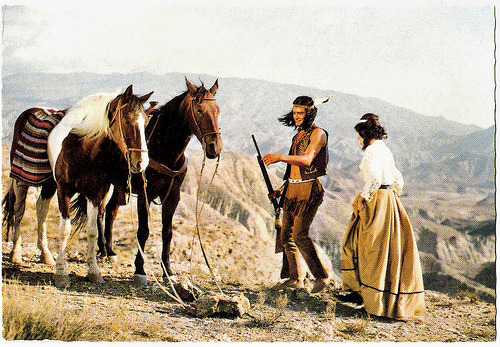
German postcard, no. 29 of 64. Photo: Constantin. Still from Der Lezte Mohikaner/The Last of the Mohicans (Harald Reinl, 1965) with Karin Dor .
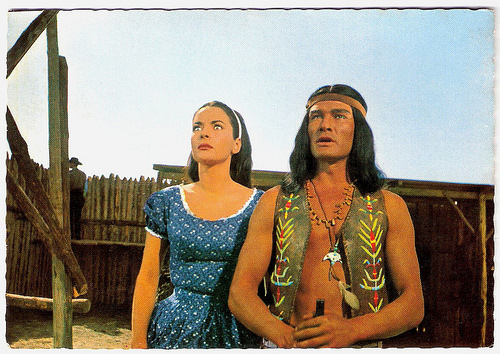
German postcard, no. 47 of 64. Photo: Constantin. Still from Der Lezte Mohikaner/The Last of the Mohicans (Harald Reinl, 1965) with Karin Dor .
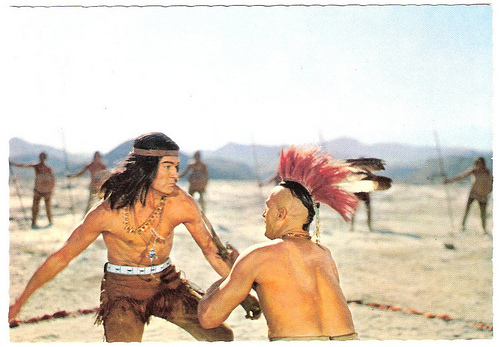
German postcard, no. 62 of 64. Photo: Constantin. Still from Der Lezte Mohikaner/The Last of the Mohicans (1965) with Ricardo Rodríguez .
Sources: Jean-Pascal Constantin (Les Gens du Cinéma - French), and Wikipedia.

German postcard, no. 1 of 64. Photo by Constantin. Still for Der Letze Mohikaner (1965) with Anthony Steffen .

German postcard, no. 53 of 64. Photo: Constantin. Still from Der Lezte Mohikaner/The Last Tomahawk (1965). Caption: Trotz des Kampfgetümmels ist Unkas das Vorgehen seines Feindes Magua nicht entgangen. Er kämpft sich frei und nimmt Maguas Spur auf. (Despite the battle tumult, Unkas did not fail to notice the actions of his enemy Magua. He fights his way free and takes Maguas track.)

German postcard, no. 58 of 64. Photo: Constantin. Still from Der Lezte Mohikaner/The Last Tomahawk (1964). Caption: "Der weise Häuptling hat beide gehört. Er befragt darauf den grossen Manitu. Das Gottesurteil lautet: Ein Zweikampf soll über Leben und Tod entscheiden." (The wise chief has heard both. He asked it the great Manitou. The judgment of the God is: a duel will decide about life and death.)
Excellent Spaghetti Western
Daniel Martin was born José Daniel Martínez Martínez in Cartagena, Spain in 1935. In 1962 he made his film debut in the historical drama La spada del Cid/The Sword of El Cid (Miguel Ilglesias, 1962).
Since this debut Martín played supporting roles and small parts in over 60 films, including many exploitation movies. He also appeared in such interesting productions as the Oscar nominated romance Los Tarantos (Francisco Rovira Beleta, 1963) with Antonio Gades, and the classic Spaghetti Western Per un pugno di dollari/A Fistful of Dollars (Sergio Leone, 1964) starring Clint Eastwood .
Other film, he appeared in were the heist caper Las Vegas, 500 millones/They Came to Rob Las Vegas (Antonio Isasi-Isasmendi, 1968), the excellent Spaghetti Western Anda muchacho, spara!/At the End of the Rainbow (Aldo Florio, 1971) with Fabio Testi, and the thriller La polizia incrimina la legge assolve/High Crime (Enzo G. Castellari, 1973) with Fernando Rey.

German postcard, no. 56 of 64. Photo: Constantin. Still from Der Lezte Mohikaner/The Last Tomahawk (1965).

German postcard, no. 4 of 64. Photo: Constantin. Still from Der Lezte Mohikaner (1965) with Anthony Steffen .

German postcard, no. 36 of 64. Photo: Constantin. Still from Der Lezte Mohikaner/The Last of the Mohicans (Harald Reinl, 1965) with Karin Dor .
The Last of the Mohicans
Under the pseudonym Dan Martin, Daniel Martín starred in Der Letze Mohikaner/The Last of the Mohicans (Harald Reinl, 1965). This Euro-western was based on the historical novel The Last of the Mohicans by James Fenimore Cooper, first published in 1826.
The story takes place in 1757, during the French and Indian War (the Seven Years' War), when France and Great Britain battled for control of the North American colonies. During this war, the French called on allied Native American tribes to fight against the more numerous British colonists.
Daniel Martín played Uncas, the son of the chief of the Mohicans. Uncas rides with his white ally, the frontiersman Natty Bumppo, known as Falkenauge/Hawkeye ( Anthony Steffen ) through the country. Soon they discover that the Huron and a gang of white bandits have destroyed the tribe of the Mohicans...
After Der Letze Mohikaner Martín also starred as Uncas in the sequel, Uncas, el fin de una raza/Fall of the Mohicans (Mateo Cano, 1965), but this time without Anthony Steffen . In 1970 both actors starred again together in the Western La caza del oro/They Believed He Was No Saint (Juan Bosch, 1972).
In the 1980s and 1990s, Martín was mostly seen in Spanish B-films and on TV. His last film was the crime film A tiro limpio/A clean shot (Jesús Mora, 1996) and his final screen appearance in the TV series Hospital Central (2002) .
Daniel Martín died in 2009 in Zaragoza, Spain, of natural causes. He was 74.

German postcard, no. 29 of 64. Photo: Constantin. Still from Der Lezte Mohikaner/The Last of the Mohicans (Harald Reinl, 1965) with Karin Dor .

German postcard, no. 47 of 64. Photo: Constantin. Still from Der Lezte Mohikaner/The Last of the Mohicans (Harald Reinl, 1965) with Karin Dor .

German postcard, no. 62 of 64. Photo: Constantin. Still from Der Lezte Mohikaner/The Last of the Mohicans (1965) with Ricardo Rodríguez .
Sources: Jean-Pascal Constantin (Les Gens du Cinéma - French), and Wikipedia.
Published on May 14, 2015 22:00
May 13, 2015
Philippe Noiret
French film actor Philippe Noiret (1930-2006) acted in several Hollywood productions, but he is best known for his roles as Alfredo in Nuovo Cinema Paradiso/Cinema Paradiso (1988), Major Dellaplane in La vie et rien d'autre/Life and Nothing But (1990) and Pablo Neruda in Il postino/Il Postino: The Postman (1994).
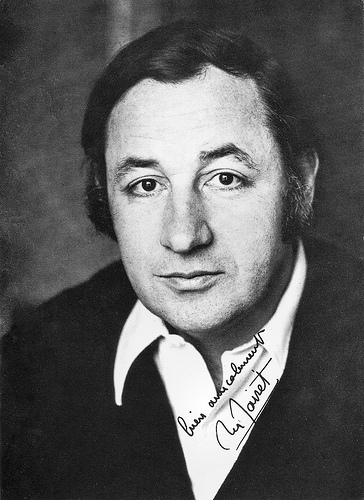
French postcard by La Roue Tourne, Paris. Imp. Rivier, no. 961-14-01.
The first film of the Nouvelle Vague
Philippe Noiret was born in Lille, France, in 1930. His parents were Lucy Noiret-Heirman and Pierre Noiret, a clothing company representative. He was an indifferent scholar and attended several prestigious Paris schools, including the Lycée Janson de Sailly. He failed several times to pass his baccalauréat exams, so he decided to study theatre.
Noiret trained at the Centre Dramatique de l'Ouest and toured with the Théâtre National Populaire for seven years, where he met actress Monique Chaumette, whom he married in 1962. During that time he developed a career as a nightclub comedian in a duo act with Jean-Pierre Darras, in which he played Louis XIV in an extravagant wig opposite Darras as the dramatist Jean Racine.
Noiret's screen debut was an uncredited role in Gigi (Jacqueline Audry, 1949) starring Gaby Morlay . Jacqueline Audry cast Noiret again in Olivia/The Pit of Loneliness (1950).
In 1955 he appeared in Agnès Varda’s debut film La Pointe Courte/The Short Point opposite Sylvia Montfort. This was considered to be the first film of the Nouvelle Vague. Sporting a pudding-basin haircut, Noiret played a lovelorn youth in the southern fishing port of Sète. No members of the cast or crew were paid during the production. The budget for the film was low, costing only $14,000. This was roughly one fourth the budget of other Nouvelle Vague films of the era such as Les 400 Coups/The 400 Blows (François Truffaut, 1959) and À Bout de Souffle/Breathless (Jean-Luc Godard, 1960) .
Noiret was not cast again until 1960 in Zazie dans le métro/Zazie in the Metro (Louis Malle, 1960), based on the novel by Raymond Queneau. Noiret played a female impersonator, who happens to be the uncle of 10-year-old Zazie (Catherine Demongeot). The provincial girl stays in Paris with him for two days, while her mother spends some time with her lover. Zazie manages to evade her uncle's custody, however, and, metro strike notwithstanding, sets out to explore the city on her own.
For his role in Thérèse Desqueyroux (Georges Franju, 1962) as the dull but inoffensive husband poisoned by his wife ( Emmanuelle Riva ), he won the best actor award at the Venice Film Festival. In the romantic adventure Le Capitaine Fracasse/Captain Fracasse (Pierre Gaspard-Huit, 1961), he played the second lead to Jean Marais . From then on, he became a regular on the French screen, without being cast in major roles until the romantic comedy La Vie de château/A Matter of Resistance (Jean-Paul Rappeneau, 1966) in which he played the male lead opposite Catherine Deneuve .
Finally, Noiret became a star in France with Alexandre le Bienheureux/Very Happy Alexander (Yves Robert, 1968). Noiret plays a henpecked childless farmer that lives oppressed by his authoritarian and materialistic wife, being the only worker in his farm. When she is killed in a car accident, the charming hedonist decides that the time has come to take it easy, locks himself up in his house with his dog and stays in bed.
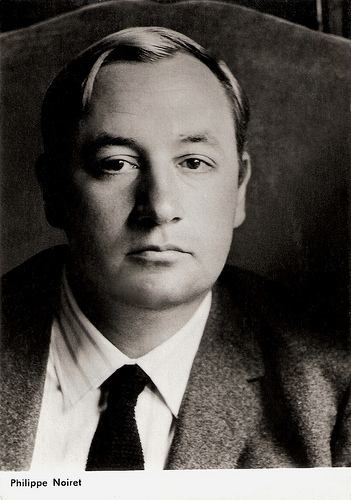
East-German postcard by VEB Progress Filmvertrieb, Berlin, no. 139 69. Photo: Unifrance Film.
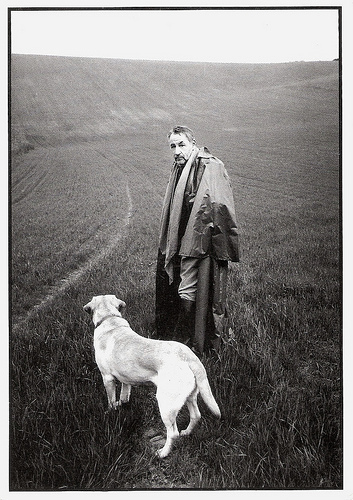
French postcard by Photomania / Studio Magazine, Paris, no. PSM 393. Photo: Luc Roux.
Everyman character and controversial
In 1976, Philippe Noiret won his first César Award for his role in Vieux Fusil/The Old Gun (Robert Enrico, 1975) opposite Romy Schneider . His second César came in 1990 for his role in La vie et rien d'autre/Life and Nothing But (Bertrand Tavernier, 1990).
He appeared in several Hollywood-financed films like The Night of the Generals (Anatole Litvak, 1967), the spy thriller Topaz (Alfred Hitchcock, 1969), the drama Justine (George Cukor, Joseph Strick, 1969), the war film Murphy's War (Peter Yates, 1971) starring Peter O'Toole , and the comedy mystery Who is Killing the Great Chefs of Europe? (Ted Kotcheff, 1978).
Philippe Noiret was cast primarily as the Everyman character, although he did not hesitate to accept controversial roles, such as in La Grande Bouffe/Blow Out (Marco Ferreri, 1973), a film about suicide by overeating, which caused a scandal at the Cannes Film Festival.
Interesting was also his role as a man leading a quiet life in a Lyons suburb, stunned when he learns that his son is wanted for murder in L'Horloger de Saint-Paul/The Watchmaker of St Paul (Bertrand Tavernier, 1974). It was the first of a dozen films he made with director Bertrand Tavernier. Their second film together was the period piece Que La Fête Commence/Let Joy Reign Supreme (Bertrand Tavernier, 1975) in which the bewigged actor seemed to relish the role of the atheistic Philippe d'Orleans. For Tavernier, he also played a good humoured but ineffectual local constable in French West Africa who becomes a serial murderer in Coup de Torchon (Bertrand Tavernier, 1981).
In Gli occhiali d'oro/The Gold Rimmed Glasses (Giuliano Montaldo, 1987), he played an elderly and respectable doctor who has a passion for a beautiful young man ( Rupert Everett ), and in J'embrasse pas/I Don't Kiss (André Téchiné, 1991), he was a melancholy old homosexual obsessed with young men.
A huge success was the Italian drama Nuovo Cinema Paradiso/Cinema Paradiso (Giuseppe Tornatore, 1988) in which he played a wonderfully warm-hearted projectionist at a failing provincial cinema, affectionately sharing his love of film with a young enthusiast. Cinema Paradiso won the Special Jury Prize at the 1989 Cannes Film Festival and the 1989 Best Foreign Language Film Oscar.
Another international success was the Italian film Il postino/Il Postino: The Postman (Michael Radford, 1994) which tells a fictional story in which the real life Chilean poet Pablo Neruda (Noiret) forms a relationship with a simple postman (Massimo Troisi) who learns to love poetry.
In 2006, Philippe Noiret died of cancer in Paris, aged 76. By the time of his death, Noiret had more than 100 film roles to his credit. In his obituary for The Guardian , Ronald Bergan wrote: “The tall, bulky build and droopy bloodhound face of Philippe Noiret, who has died aged 76, were significant features on the European cinema landscape for more than half a century.”
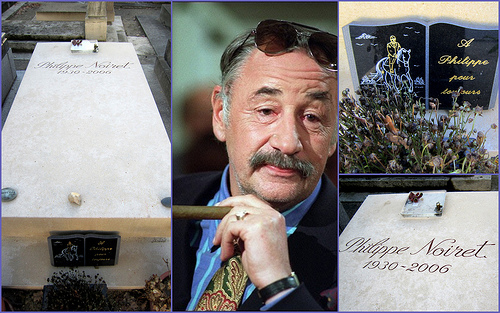
Collage by Kay Harpa @ Flickr.
Trailer Nuovo Cinema Paradiso/Cinema Paradiso (1988). Source: Ageless Trailers (YouTube).
Trailer Il postino/Il Postino: The Postman (1994). Source: grandepuffo20 (YouTube).
Sources: Ronald Bergan (The Guardian), Wikipedia and .

French postcard by La Roue Tourne, Paris. Imp. Rivier, no. 961-14-01.
The first film of the Nouvelle Vague
Philippe Noiret was born in Lille, France, in 1930. His parents were Lucy Noiret-Heirman and Pierre Noiret, a clothing company representative. He was an indifferent scholar and attended several prestigious Paris schools, including the Lycée Janson de Sailly. He failed several times to pass his baccalauréat exams, so he decided to study theatre.
Noiret trained at the Centre Dramatique de l'Ouest and toured with the Théâtre National Populaire for seven years, where he met actress Monique Chaumette, whom he married in 1962. During that time he developed a career as a nightclub comedian in a duo act with Jean-Pierre Darras, in which he played Louis XIV in an extravagant wig opposite Darras as the dramatist Jean Racine.
Noiret's screen debut was an uncredited role in Gigi (Jacqueline Audry, 1949) starring Gaby Morlay . Jacqueline Audry cast Noiret again in Olivia/The Pit of Loneliness (1950).
In 1955 he appeared in Agnès Varda’s debut film La Pointe Courte/The Short Point opposite Sylvia Montfort. This was considered to be the first film of the Nouvelle Vague. Sporting a pudding-basin haircut, Noiret played a lovelorn youth in the southern fishing port of Sète. No members of the cast or crew were paid during the production. The budget for the film was low, costing only $14,000. This was roughly one fourth the budget of other Nouvelle Vague films of the era such as Les 400 Coups/The 400 Blows (François Truffaut, 1959) and À Bout de Souffle/Breathless (Jean-Luc Godard, 1960) .
Noiret was not cast again until 1960 in Zazie dans le métro/Zazie in the Metro (Louis Malle, 1960), based on the novel by Raymond Queneau. Noiret played a female impersonator, who happens to be the uncle of 10-year-old Zazie (Catherine Demongeot). The provincial girl stays in Paris with him for two days, while her mother spends some time with her lover. Zazie manages to evade her uncle's custody, however, and, metro strike notwithstanding, sets out to explore the city on her own.
For his role in Thérèse Desqueyroux (Georges Franju, 1962) as the dull but inoffensive husband poisoned by his wife ( Emmanuelle Riva ), he won the best actor award at the Venice Film Festival. In the romantic adventure Le Capitaine Fracasse/Captain Fracasse (Pierre Gaspard-Huit, 1961), he played the second lead to Jean Marais . From then on, he became a regular on the French screen, without being cast in major roles until the romantic comedy La Vie de château/A Matter of Resistance (Jean-Paul Rappeneau, 1966) in which he played the male lead opposite Catherine Deneuve .
Finally, Noiret became a star in France with Alexandre le Bienheureux/Very Happy Alexander (Yves Robert, 1968). Noiret plays a henpecked childless farmer that lives oppressed by his authoritarian and materialistic wife, being the only worker in his farm. When she is killed in a car accident, the charming hedonist decides that the time has come to take it easy, locks himself up in his house with his dog and stays in bed.

East-German postcard by VEB Progress Filmvertrieb, Berlin, no. 139 69. Photo: Unifrance Film.

French postcard by Photomania / Studio Magazine, Paris, no. PSM 393. Photo: Luc Roux.
Everyman character and controversial
In 1976, Philippe Noiret won his first César Award for his role in Vieux Fusil/The Old Gun (Robert Enrico, 1975) opposite Romy Schneider . His second César came in 1990 for his role in La vie et rien d'autre/Life and Nothing But (Bertrand Tavernier, 1990).
He appeared in several Hollywood-financed films like The Night of the Generals (Anatole Litvak, 1967), the spy thriller Topaz (Alfred Hitchcock, 1969), the drama Justine (George Cukor, Joseph Strick, 1969), the war film Murphy's War (Peter Yates, 1971) starring Peter O'Toole , and the comedy mystery Who is Killing the Great Chefs of Europe? (Ted Kotcheff, 1978).
Philippe Noiret was cast primarily as the Everyman character, although he did not hesitate to accept controversial roles, such as in La Grande Bouffe/Blow Out (Marco Ferreri, 1973), a film about suicide by overeating, which caused a scandal at the Cannes Film Festival.
Interesting was also his role as a man leading a quiet life in a Lyons suburb, stunned when he learns that his son is wanted for murder in L'Horloger de Saint-Paul/The Watchmaker of St Paul (Bertrand Tavernier, 1974). It was the first of a dozen films he made with director Bertrand Tavernier. Their second film together was the period piece Que La Fête Commence/Let Joy Reign Supreme (Bertrand Tavernier, 1975) in which the bewigged actor seemed to relish the role of the atheistic Philippe d'Orleans. For Tavernier, he also played a good humoured but ineffectual local constable in French West Africa who becomes a serial murderer in Coup de Torchon (Bertrand Tavernier, 1981).
In Gli occhiali d'oro/The Gold Rimmed Glasses (Giuliano Montaldo, 1987), he played an elderly and respectable doctor who has a passion for a beautiful young man ( Rupert Everett ), and in J'embrasse pas/I Don't Kiss (André Téchiné, 1991), he was a melancholy old homosexual obsessed with young men.
A huge success was the Italian drama Nuovo Cinema Paradiso/Cinema Paradiso (Giuseppe Tornatore, 1988) in which he played a wonderfully warm-hearted projectionist at a failing provincial cinema, affectionately sharing his love of film with a young enthusiast. Cinema Paradiso won the Special Jury Prize at the 1989 Cannes Film Festival and the 1989 Best Foreign Language Film Oscar.
Another international success was the Italian film Il postino/Il Postino: The Postman (Michael Radford, 1994) which tells a fictional story in which the real life Chilean poet Pablo Neruda (Noiret) forms a relationship with a simple postman (Massimo Troisi) who learns to love poetry.
In 2006, Philippe Noiret died of cancer in Paris, aged 76. By the time of his death, Noiret had more than 100 film roles to his credit. In his obituary for The Guardian , Ronald Bergan wrote: “The tall, bulky build and droopy bloodhound face of Philippe Noiret, who has died aged 76, were significant features on the European cinema landscape for more than half a century.”

Collage by Kay Harpa @ Flickr.
Trailer Nuovo Cinema Paradiso/Cinema Paradiso (1988). Source: Ageless Trailers (YouTube).
Trailer Il postino/Il Postino: The Postman (1994). Source: grandepuffo20 (YouTube).
Sources: Ronald Bergan (The Guardian), Wikipedia and .
Published on May 13, 2015 22:00
May 12, 2015
Kwatta
The Belgian-Dutch chocolate factory Kwatta produced several sets of Film Star trading cards during the late 1940s. The black and white and colour cards of Hollywood stars were issued with the Kwatta chocolates.
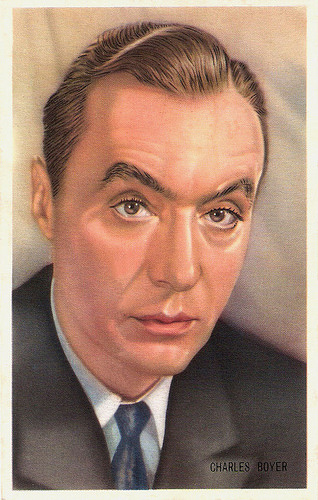
Charles Boyer . Belgian collectors card by Kwatta, Bois d'Haine, no. C. 112. Photo: Metro Goldwyn Mayer (M.G.M.). Publicity still for Arch of Triumph (Lewis Milestone, 1948).
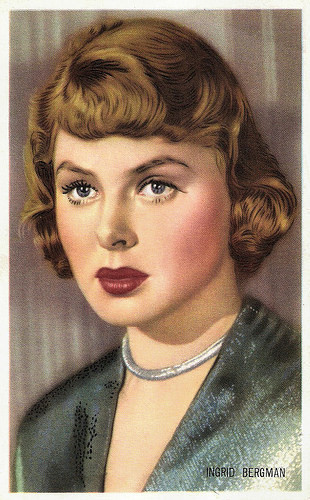
Ingrid Bergman . Belgian collectors card by Kwatta, Bois d'Haine, no. C. 210. Image: Metro Goldwyn Mayer (M.G.M.). Publicity picture for Arch of Triumph (Lewis Milestone, 1948).
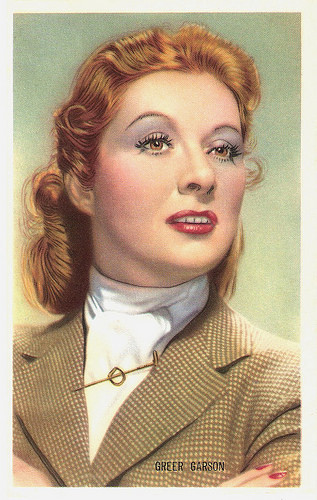
Greer Garson . Belgian collectors card by Kwatta, Bois d'Haine, no. C. 203. Photo: M.G.M.
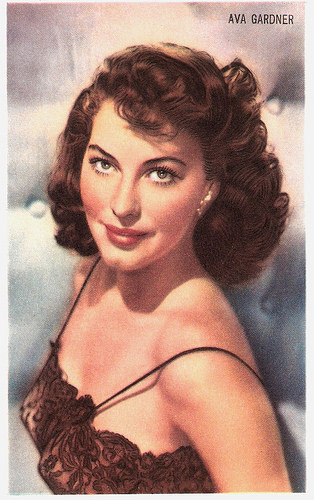
Ava Gardner. Belgian collectors card by Kwatta, Bois d'Haine, no. C. 234. Photo: M.G.M. Publicity still for East Side, West Side (Mervyn LeRoy, 1949).
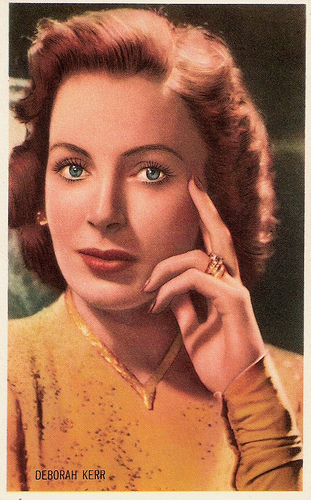
Deborah Kerr. Belgian collectors card by Kwatta, Bois D'Haine, no. C. 252.
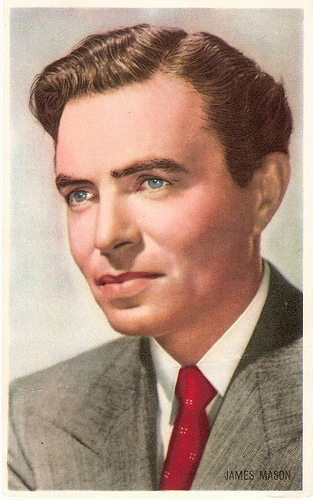
James Mason . Belgian collectors card by Kwatta, no. C. 265. Photo: M.G.M. Publicity still for East Side, West Side (Mervyn Leroy, 1949).
Suriname - Netherlands - Belgium - US
The Kwatta company was founded in 1883 by P. de Bondt and Joseph Gustaaf van Emden. They produced chocolate in a factory in Breda in the south of the Netherlands with cacao from the Kwatta plantation in Suriname, then a Dutch colony.
At the outbreak in 1907 of the cocoa market crisis the prices rose sharply and a lot of cocoa and chocolate companies closed their doors. Kwatta NV survived this crisis thanks to their packaged chocolate bar.
This Kwatta-bar was so popular among the soldiers that the army was the largest buyer and the Kwatta bar was for sale in all barracks.
In 1913 it became a Dutch-Belgian company when a chocolate factory was opened in Bois-d'Haine, Belgium. Subsidiaries in Germany and France followed.
In 1972 Kwatta became a full Belgian brand and since 2001 the American multinational Heinz owns the brand.
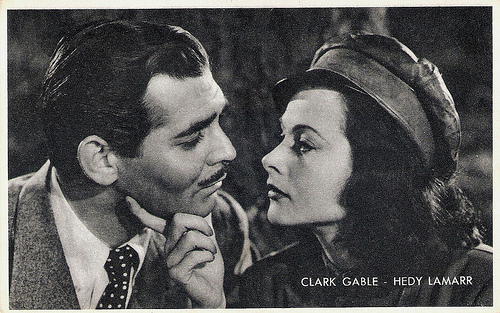
Belgian collector's card by Kwatta, Series C, no. 166. Photo: M.G.M. Publicity still for Comrade X (King Vidor, 1940) with Clark Gable and Hedy Lamarr .
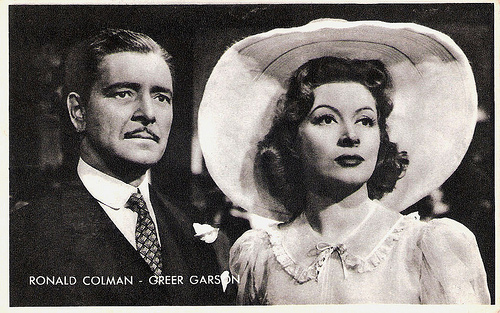
Belgian collector's card by Kwatta, Bois-D'Haine, no. C. 170. Photo: M.G.M. Publicity still for Random Harvest (1942) with Ronald Colman and Greer Garson .
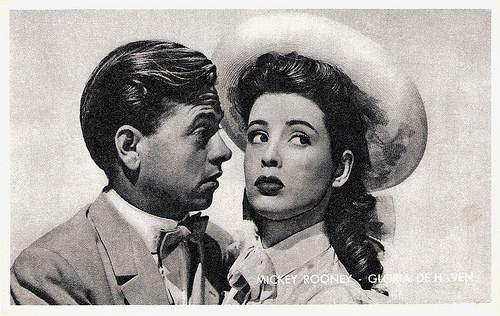
Belgian collectors card by Kwatta, Bois d'Haine, no. C. 172. Photo: M.G.M. Publicity still for Summer Holiday (Rouben Mamoulian, 1948) with Mickey Rooney and Gloria De Haven.
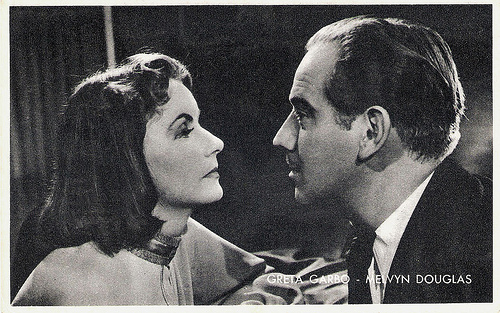
Belgian collectors card by Kwatta, no. C. 181. Photo: M.G.M. Publicity still for Ninotschka (Ernst Lubitsch, 1939) with Greta Garbo and Melvyn Douglas.
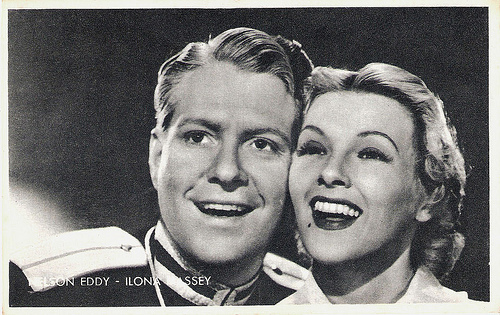
Belgian collectors card by Kwatta, no. C. 182. Photo: M.G.M. Publicity still for Balalaika (Reinhold Schünzel, 1939) with Ilona Massey and Nelson Eddy.
Film star trading cards
“Early film star cards were most commonly issued in tobacco packs though cards also commonly came with candy and gum as well as other items such as bread, cookies and other food products; magazine supplements; even sewing needles in one case!”, writes Cliff Aliperti at his beautiful website Immortal Ephemera.
After the second World War, Kwatta issued several sets of film star trading cards. Some were in black and white, others in colour.
Also the measures differed. The cards of the first series of 96 cards measured about 2,5 x 7,6 cm (1-7/8" X 3-1/16") with the stars name and studio listed at the bottom. Following sets measured 5 x 7 cm (2" x 2-3/4") and finally there were sets of ostcard sized cards of 8 x 13 cm (3-1/4" x 5-1/4"). The latter was the C-series, shown in this post.
At the back side there was information in French and in Dutch, the two languages of Belgium. The cards could be collected in a pocket album named Ciné Stars. On the cover was a lion, which referred to Metro-Goldwyn-Mayer. And indeed, most stars were under contract with MGM.
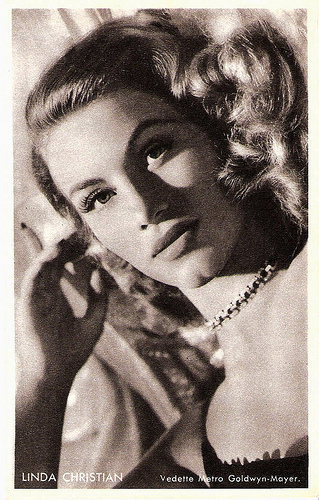
Linda Christian . Belgian card by Kwatta. Photo: M.G.M.
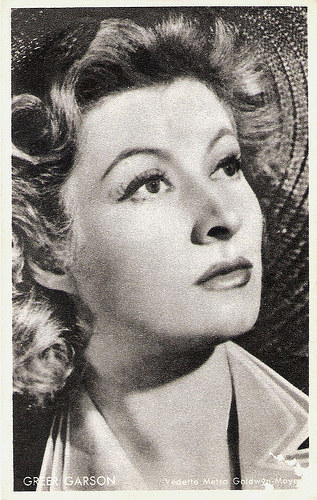
Greer Garson . Belgian collectors card by Kwatta, Bois d'Haine, no. C. 2. Photo: Metro Goldwyn Mayer.
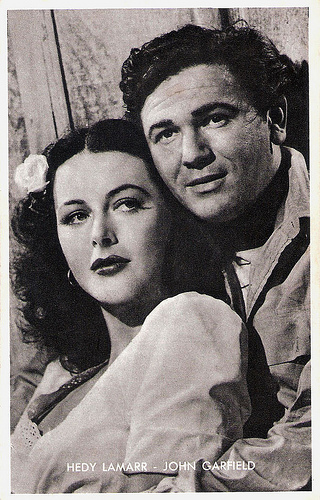
Belgian collectors card by Kwatta, no. C. 154 Photo: M.G.M. Publicity still for Tortilla Flat (Victor Fleming, 1942) with Hedy Lamarr and John Garfield.
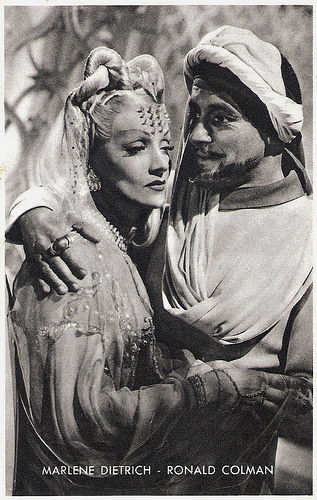
Belgian collectors card by Kwatta, Bois d'Haine, no. C. 156. Photo: M.G.M. Publicity still for Kismet (William Dieterle, 1944) with Marlene Dietrich and Ronald Colman .
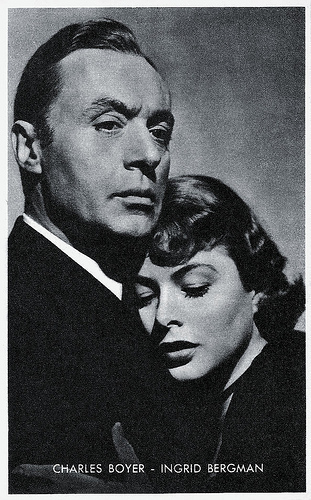
Belgian collectors card by Kwatta, Bois d'Haine, no. C. 176. Photo: M.G.M. Publicity still for Arch of Triumph (Lewis Milestone, 1948) with Charles Boyer and Ingrid Bergman .
This was the ninth post in a series on film star postcard publishers. Next week: Alterocca. For earlier posts, see the links at right under the caption 'The Publishers'.
Sources: Cliff Aliperti (Immortal Ephemera), Troy Kirk (The Movie Card Website), and Wikipedia (Dutch).

Charles Boyer . Belgian collectors card by Kwatta, Bois d'Haine, no. C. 112. Photo: Metro Goldwyn Mayer (M.G.M.). Publicity still for Arch of Triumph (Lewis Milestone, 1948).

Ingrid Bergman . Belgian collectors card by Kwatta, Bois d'Haine, no. C. 210. Image: Metro Goldwyn Mayer (M.G.M.). Publicity picture for Arch of Triumph (Lewis Milestone, 1948).

Greer Garson . Belgian collectors card by Kwatta, Bois d'Haine, no. C. 203. Photo: M.G.M.

Ava Gardner. Belgian collectors card by Kwatta, Bois d'Haine, no. C. 234. Photo: M.G.M. Publicity still for East Side, West Side (Mervyn LeRoy, 1949).

Deborah Kerr. Belgian collectors card by Kwatta, Bois D'Haine, no. C. 252.

James Mason . Belgian collectors card by Kwatta, no. C. 265. Photo: M.G.M. Publicity still for East Side, West Side (Mervyn Leroy, 1949).
Suriname - Netherlands - Belgium - US
The Kwatta company was founded in 1883 by P. de Bondt and Joseph Gustaaf van Emden. They produced chocolate in a factory in Breda in the south of the Netherlands with cacao from the Kwatta plantation in Suriname, then a Dutch colony.
At the outbreak in 1907 of the cocoa market crisis the prices rose sharply and a lot of cocoa and chocolate companies closed their doors. Kwatta NV survived this crisis thanks to their packaged chocolate bar.
This Kwatta-bar was so popular among the soldiers that the army was the largest buyer and the Kwatta bar was for sale in all barracks.
In 1913 it became a Dutch-Belgian company when a chocolate factory was opened in Bois-d'Haine, Belgium. Subsidiaries in Germany and France followed.
In 1972 Kwatta became a full Belgian brand and since 2001 the American multinational Heinz owns the brand.

Belgian collector's card by Kwatta, Series C, no. 166. Photo: M.G.M. Publicity still for Comrade X (King Vidor, 1940) with Clark Gable and Hedy Lamarr .

Belgian collector's card by Kwatta, Bois-D'Haine, no. C. 170. Photo: M.G.M. Publicity still for Random Harvest (1942) with Ronald Colman and Greer Garson .

Belgian collectors card by Kwatta, Bois d'Haine, no. C. 172. Photo: M.G.M. Publicity still for Summer Holiday (Rouben Mamoulian, 1948) with Mickey Rooney and Gloria De Haven.

Belgian collectors card by Kwatta, no. C. 181. Photo: M.G.M. Publicity still for Ninotschka (Ernst Lubitsch, 1939) with Greta Garbo and Melvyn Douglas.

Belgian collectors card by Kwatta, no. C. 182. Photo: M.G.M. Publicity still for Balalaika (Reinhold Schünzel, 1939) with Ilona Massey and Nelson Eddy.
Film star trading cards
“Early film star cards were most commonly issued in tobacco packs though cards also commonly came with candy and gum as well as other items such as bread, cookies and other food products; magazine supplements; even sewing needles in one case!”, writes Cliff Aliperti at his beautiful website Immortal Ephemera.
After the second World War, Kwatta issued several sets of film star trading cards. Some were in black and white, others in colour.
Also the measures differed. The cards of the first series of 96 cards measured about 2,5 x 7,6 cm (1-7/8" X 3-1/16") with the stars name and studio listed at the bottom. Following sets measured 5 x 7 cm (2" x 2-3/4") and finally there were sets of ostcard sized cards of 8 x 13 cm (3-1/4" x 5-1/4"). The latter was the C-series, shown in this post.
At the back side there was information in French and in Dutch, the two languages of Belgium. The cards could be collected in a pocket album named Ciné Stars. On the cover was a lion, which referred to Metro-Goldwyn-Mayer. And indeed, most stars were under contract with MGM.

Linda Christian . Belgian card by Kwatta. Photo: M.G.M.

Greer Garson . Belgian collectors card by Kwatta, Bois d'Haine, no. C. 2. Photo: Metro Goldwyn Mayer.

Belgian collectors card by Kwatta, no. C. 154 Photo: M.G.M. Publicity still for Tortilla Flat (Victor Fleming, 1942) with Hedy Lamarr and John Garfield.

Belgian collectors card by Kwatta, Bois d'Haine, no. C. 156. Photo: M.G.M. Publicity still for Kismet (William Dieterle, 1944) with Marlene Dietrich and Ronald Colman .

Belgian collectors card by Kwatta, Bois d'Haine, no. C. 176. Photo: M.G.M. Publicity still for Arch of Triumph (Lewis Milestone, 1948) with Charles Boyer and Ingrid Bergman .
This was the ninth post in a series on film star postcard publishers. Next week: Alterocca. For earlier posts, see the links at right under the caption 'The Publishers'.
Sources: Cliff Aliperti (Immortal Ephemera), Troy Kirk (The Movie Card Website), and Wikipedia (Dutch).
Published on May 12, 2015 22:00
May 9, 2015
Anouk Aimée
Glamorous French film actressAnouk Aimée (1932) has appeared in 70 films since 1947 and worked with many talented directors. She had major international successes in the 1960s with Lola (1961) and Un homme et une femme/A Man and a Woman (1966) in which she defined a new kind of modern heroine.
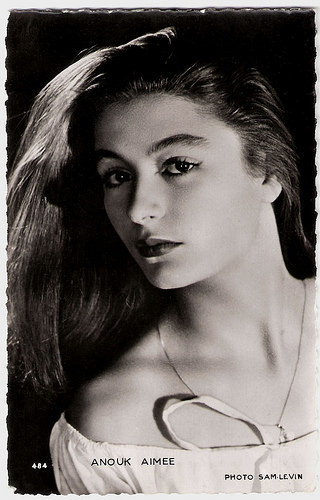
French postcard by Editions P.I., no. 484. Photo: Sam Lévin.
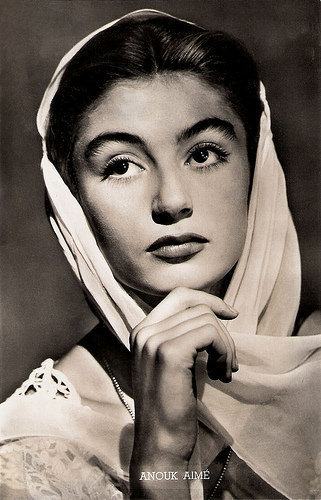
Dutch postcard, no. 453. Photo: Cornel Lucas.
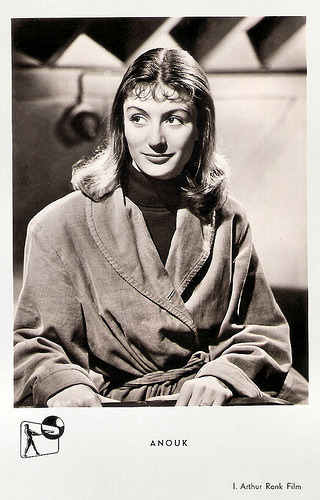
German postcard by Film und Bild, Berlin, no. A 1029. Photo: J. Arthur Rank Film. Publicity still for The Man Who Watched Trains Go By (Harold French, 1952).
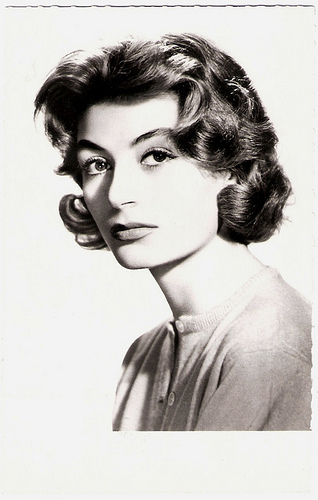
French postcard by Editions P.I., Paris, no. 952. Photo: Sam Lévin.
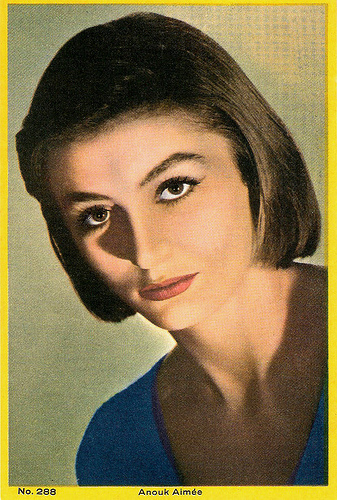
Mexican card, no. 288.
Romeo and Juliet
Anouk Aimée was born Françoise Nicole Sorya Dreyfus in Paris, France, in 1932. She was the daughter of actors Geneviève Sorya (née Durand) and Henri Murray (born Dreyfus). She was trained in acting and dancing at the Bauer-Therond school.
Aimée began her film career in 1946 at the age of 14. Reportedly she was walking down the rue Colisée in the eighth arrondissement in Paris with her mother, when director Henri Calef stopped her and asked if she would like to be in a film. Her film debut was La maison sous la mer/The House by the Sea (Henri Calef, 1947) starring Viviane Romance .
At first she was simply billed as Anouk, taken from the character she played in Marcel Carné’s unfinished film La Fleur de l’âge/The Flower of the Age (1947).
She played Juliette opposite Serge Reggiani as Romeo in Les amants de Vérone/Lovers of Verona (Andre Cayatte, 1949), an updated adaptation of William Shakespeare's Romeo and Juliet, specifically written for her by the poet Jacques Prevert. Prévert playfully added the symbolic last name, Aimée (Beloved), that would forever associate her with the affective power of her screen roles. Les amants de Vérone was a worldwide success.
She then worked three times with director Alexandre Astruc, at Le Rideau Cramoisi/The Crimson Curtain (1951), Deux Crimes d'Amour/Two Love Crimes (1953) and Les Mauvaises Rencontres/The Bad Liaisons (1955). She appeared in the British espionage drama Contraband Spain (Lawrence Huntington, 1955) opposite Richard Greene , and starred in the ‘perfect crime’ melodrama Tous Peuvent Me Tuer/Everybody Wants To Kill Me (Henri Decoin, 1956).
In 1958 she portrayed the artist Jeanne Hébuterne in Les Amants de Montparnasse/Montparnasse 19 (1958) about the tragic, troubled life of Italian abstract painter Amedeo Modigliani ( Gérard Philipe ). She made her Hollywood debut as a French Resistance fighter in The Journey (Anatole Litvak, 1959).
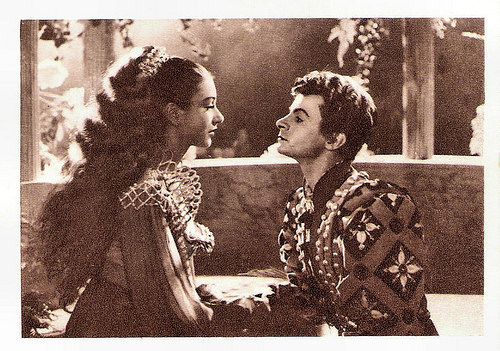
French collectors card. Photo: publicity still for Les amants de Vérone/The Lovers of Verona (André Cayatte, 1949) with Serge Reggiani .
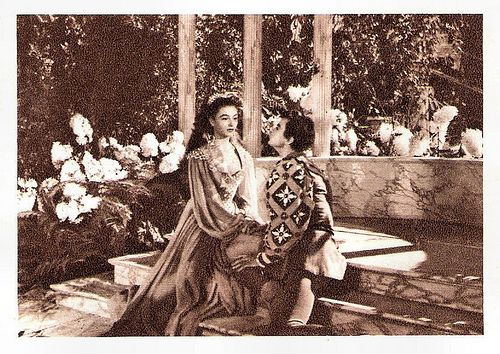
French collectors card. Photo: publicity still for Les amants de Vérone/The Lovers of Verona (André Cayatte, 1949) with Serge Reggiani .
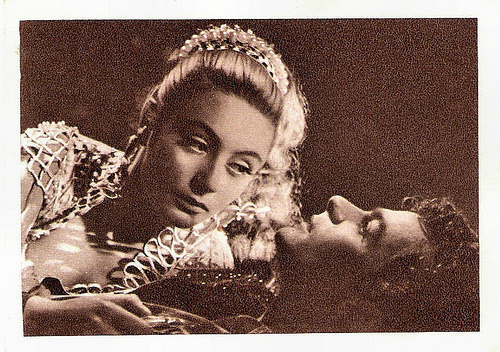
French collectors card. Photo: publicity still for Les amants de Vérone/The Lovers of Verona (André Cayatte, 1949) with Serge Reggiani .
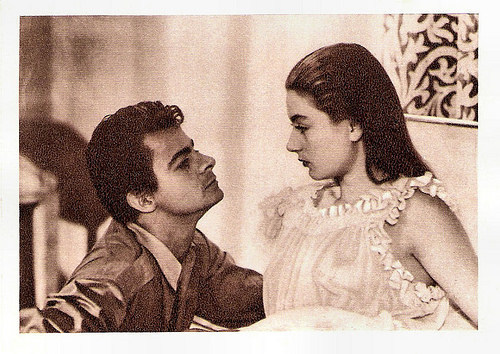
French collectors card. Photo: publicity still for Les amants de Vérone/The Lovers of Verona (André Cayatte, 1949) with Serge Reggiani .
Musical Without Music
Possessed of an aloof, haunting beauty, Anouk Aimée has given her best performances under the direction of such master directors as Federico Fellini and Jacques Demy. She appeared in two major films by Fellini, as a bored socialite in La dolce vita/The Sweet Life (Federico Fellini, 1960) and as Marcello Mastroianni ’s long-suffering wife in 8 ½ (1963).
Aimée had a huge success with Jacques Demy's debut film Lola (1961), a musical ‘without music’ set in the port city of Nantes. Aimée stars as the title character, a cabaret singer awaiting the return of her long-absent lover and the father of her child, who went to America seven years ago and promised to return when he became rich.
Another milestone was her work as the sexually ambivalent queen in the bible epic Sodom and Gomorrah (Robert Aldrich, 1962). Aimee reunited with Jacques Demy for The Model Shop (1969), in which Lola is an older French model living in Los Angeles who poses for photographs to pay the bills.
In between these two films, she played Anne Gauthier in the wildly romantic drama Un homme et une femme/A Man and a Woman (Claude Lelouch, 1966), a widow who falls in love with widower Jean-Louis Trintignant . This role brought her more international fame and awards. She won the 1967 Golden Globe Award for Best Actress - Motion Picture Drama and was nominated for an Academy Award for Best Actress.
She had the chance to establish herself in Hollywood but she refused many roles, including that of Vicki Anderson, the insurance investigator eventually played by Faye Dunaway opposite Steve McQueen in the first The Thomas Crown Affair (Norman Jewison, 1968). She did play the title role in Justine (George Cukor, 1969) with Michael York and in The Appointment (Sidney Lumet, 1969) with Omar Sharif, but her American film career went nowhere.
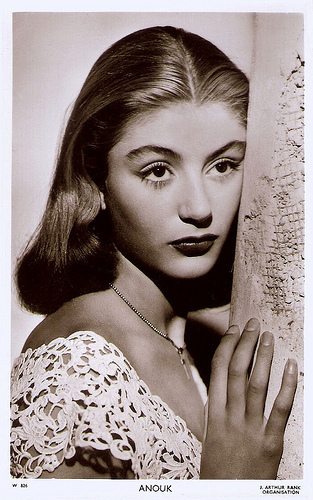
British postcard by Picturegoer Post Card, London, no. W 826. Photo: J. Arthur Rank Organisation.
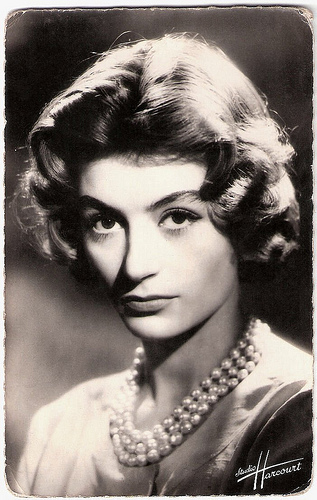
French postcard by Editions du Globe (E.D.U.G.), Paris, no. 702. Photo: Studio Harcourt.
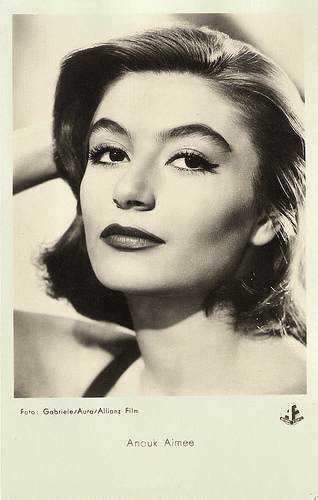
French postcard by Editions P.I., Paris, no. FK 2195. Photo: Gabriele / Aura / Allianz-Film.
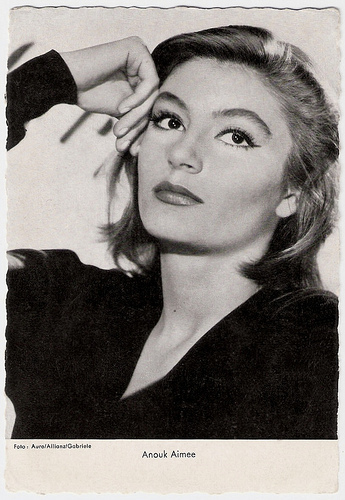
German card by WS-Druck, Wanne-Eickel. Photo: Aura / Allianz / Gabriele.
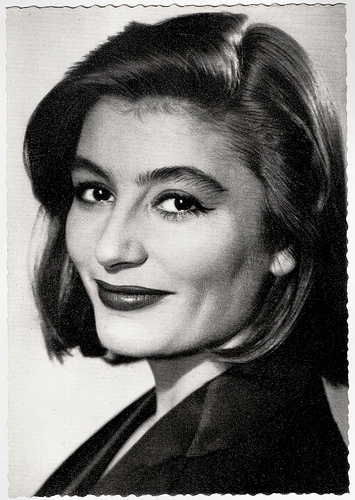
German postcard by Filmbilder-Vertrieb Ernst Freihoff, Essen, no. 116. Photo: Allianz Film.
Icon of Cool
After a break of seven years, Anouk Aimée returned to the cinema in Si C'Etait à Refaire/If It Could Be Done Over Again (Claude Lelouch, 1976) with Catherine Deneuve as two former prison buddies who get on with the business of living.
She was awarded the Award for Best Actress at the 1980 Cannes Film Festival for her performance in Marco Bellocchio's Salto nel vuoto/Leap Into The Void (1979), her co-star Michel Piccoli winning the Best Actor Prize. It was followed by roles in La Tragedia di un Uomo Ridicolo/The Tragedy of a Ridiculous Man (Bernardo Bertolucci, 1980) opposite Ugo Tognazzi , and Success is the Best Revenge (Jerzy Skolimowsky, 1984) starring Michael York.
Looking every bit as alluring as she had in 1966, Aimee reprised her most famous role as Anne Gauthier in Un Homme et une Femme: Vingt Ans Déjà/A Man and a Woman: Twenty Years Later (Claude Lelouch, 1986), again opposite Jean-Louis Trintignant .
She also portrayed the worldly-wise designer Simone Lowenthal in Prêt-à-Porter/Ready to Wear (1994), Robert Altman's comedy about the Parisian fashion scene.
Aimée was married four times. From 1949 till 1950 she was married to Edouard Zimmermann. Her second husband (1951–1954) was the film director Nikos Papatakis, with whom she has a daughter Manuela (1951). Her third marriage was to composer Pierre Barouh (1966-1969). From 1970 to 1978, she was married to the British actor Albert Finney .
Aimée is known as a champion of human rights. In 2002 she supported Lionel Jospin's presidential campaign. That year she was awarded a César d'honneur (a honorary César Award), and the following year she received an honorary Golden Bear at the Berlin Film Festival.
As Sandy Flitterman-Lewis writes in the Jewish Women Encyclopedia , Anouk Aimée is still “known for her remarkable presence as an icon of cool, sophisticated beauty in more than seventy films across seven decades. (...) Words like ‘regal,’ ‘intelligent’ and ‘enigmatic’ are frequently associated with her, giving Aimée an aura of disturbing and mysterious beauty that has earned her the status of one of the hundred sexiest stars in film history (in a 1995 poll conducted by Empire Magazine )”.
Now in her seventies, Anouk Aimee is still very active. More recent films in which she appeared, include the comedy Ils se marièrent et eurent beaucoup d'enfants/Happily Ever After (Yvan Attal, 2004) with Charlotte Gainsbourg , the political thriller De Particulier à Particulier/Hotel Harabati (Brice Chauvin, 2006), Celle que j'aime/The One I Love (Elie Chouraqui, 2009), the romance Ces amours-là/These Courtship (Claude Lelouch, 2010) and Paris Connections (Harley Cokeliss, 2010), a glittering adaptation of a Jackie Collins novel produced by American supermarket giant Tesco.
Anouk Aimée lives in the Montmartre section of Paris with her daughter Manuela.
Scene from Les amants de Vérone/Lovers of Verona (1949). Source: Miirdza (YouTube).
French trailer of Lola (1961). Source: Fondation Gan pour le Cinéma (YouTube).
Trailer for 8 1/2 (1963). Source: Soundtracks and Trailers (YouTube_.
Scene from Un homme et une femme/A Man and a Woman (1966). Source: Leony1948 (YouTube).
Trailer of Justine (1969). Source: modcinema (YouTube).
Sources: Hal Erickson (AllMovie), (IMDb), Sandy Flitterman-Lewis (Jewish Women Encyclopedia), AlloCiné (French), Wikipedia, and .

French postcard by Editions P.I., no. 484. Photo: Sam Lévin.

Dutch postcard, no. 453. Photo: Cornel Lucas.

German postcard by Film und Bild, Berlin, no. A 1029. Photo: J. Arthur Rank Film. Publicity still for The Man Who Watched Trains Go By (Harold French, 1952).

French postcard by Editions P.I., Paris, no. 952. Photo: Sam Lévin.

Mexican card, no. 288.
Romeo and Juliet
Anouk Aimée was born Françoise Nicole Sorya Dreyfus in Paris, France, in 1932. She was the daughter of actors Geneviève Sorya (née Durand) and Henri Murray (born Dreyfus). She was trained in acting and dancing at the Bauer-Therond school.
Aimée began her film career in 1946 at the age of 14. Reportedly she was walking down the rue Colisée in the eighth arrondissement in Paris with her mother, when director Henri Calef stopped her and asked if she would like to be in a film. Her film debut was La maison sous la mer/The House by the Sea (Henri Calef, 1947) starring Viviane Romance .
At first she was simply billed as Anouk, taken from the character she played in Marcel Carné’s unfinished film La Fleur de l’âge/The Flower of the Age (1947).
She played Juliette opposite Serge Reggiani as Romeo in Les amants de Vérone/Lovers of Verona (Andre Cayatte, 1949), an updated adaptation of William Shakespeare's Romeo and Juliet, specifically written for her by the poet Jacques Prevert. Prévert playfully added the symbolic last name, Aimée (Beloved), that would forever associate her with the affective power of her screen roles. Les amants de Vérone was a worldwide success.
She then worked three times with director Alexandre Astruc, at Le Rideau Cramoisi/The Crimson Curtain (1951), Deux Crimes d'Amour/Two Love Crimes (1953) and Les Mauvaises Rencontres/The Bad Liaisons (1955). She appeared in the British espionage drama Contraband Spain (Lawrence Huntington, 1955) opposite Richard Greene , and starred in the ‘perfect crime’ melodrama Tous Peuvent Me Tuer/Everybody Wants To Kill Me (Henri Decoin, 1956).
In 1958 she portrayed the artist Jeanne Hébuterne in Les Amants de Montparnasse/Montparnasse 19 (1958) about the tragic, troubled life of Italian abstract painter Amedeo Modigliani ( Gérard Philipe ). She made her Hollywood debut as a French Resistance fighter in The Journey (Anatole Litvak, 1959).

French collectors card. Photo: publicity still for Les amants de Vérone/The Lovers of Verona (André Cayatte, 1949) with Serge Reggiani .

French collectors card. Photo: publicity still for Les amants de Vérone/The Lovers of Verona (André Cayatte, 1949) with Serge Reggiani .

French collectors card. Photo: publicity still for Les amants de Vérone/The Lovers of Verona (André Cayatte, 1949) with Serge Reggiani .

French collectors card. Photo: publicity still for Les amants de Vérone/The Lovers of Verona (André Cayatte, 1949) with Serge Reggiani .
Musical Without Music
Possessed of an aloof, haunting beauty, Anouk Aimée has given her best performances under the direction of such master directors as Federico Fellini and Jacques Demy. She appeared in two major films by Fellini, as a bored socialite in La dolce vita/The Sweet Life (Federico Fellini, 1960) and as Marcello Mastroianni ’s long-suffering wife in 8 ½ (1963).
Aimée had a huge success with Jacques Demy's debut film Lola (1961), a musical ‘without music’ set in the port city of Nantes. Aimée stars as the title character, a cabaret singer awaiting the return of her long-absent lover and the father of her child, who went to America seven years ago and promised to return when he became rich.
Another milestone was her work as the sexually ambivalent queen in the bible epic Sodom and Gomorrah (Robert Aldrich, 1962). Aimee reunited with Jacques Demy for The Model Shop (1969), in which Lola is an older French model living in Los Angeles who poses for photographs to pay the bills.
In between these two films, she played Anne Gauthier in the wildly romantic drama Un homme et une femme/A Man and a Woman (Claude Lelouch, 1966), a widow who falls in love with widower Jean-Louis Trintignant . This role brought her more international fame and awards. She won the 1967 Golden Globe Award for Best Actress - Motion Picture Drama and was nominated for an Academy Award for Best Actress.
She had the chance to establish herself in Hollywood but she refused many roles, including that of Vicki Anderson, the insurance investigator eventually played by Faye Dunaway opposite Steve McQueen in the first The Thomas Crown Affair (Norman Jewison, 1968). She did play the title role in Justine (George Cukor, 1969) with Michael York and in The Appointment (Sidney Lumet, 1969) with Omar Sharif, but her American film career went nowhere.

British postcard by Picturegoer Post Card, London, no. W 826. Photo: J. Arthur Rank Organisation.

French postcard by Editions du Globe (E.D.U.G.), Paris, no. 702. Photo: Studio Harcourt.

French postcard by Editions P.I., Paris, no. FK 2195. Photo: Gabriele / Aura / Allianz-Film.

German card by WS-Druck, Wanne-Eickel. Photo: Aura / Allianz / Gabriele.

German postcard by Filmbilder-Vertrieb Ernst Freihoff, Essen, no. 116. Photo: Allianz Film.
Icon of Cool
After a break of seven years, Anouk Aimée returned to the cinema in Si C'Etait à Refaire/If It Could Be Done Over Again (Claude Lelouch, 1976) with Catherine Deneuve as two former prison buddies who get on with the business of living.
She was awarded the Award for Best Actress at the 1980 Cannes Film Festival for her performance in Marco Bellocchio's Salto nel vuoto/Leap Into The Void (1979), her co-star Michel Piccoli winning the Best Actor Prize. It was followed by roles in La Tragedia di un Uomo Ridicolo/The Tragedy of a Ridiculous Man (Bernardo Bertolucci, 1980) opposite Ugo Tognazzi , and Success is the Best Revenge (Jerzy Skolimowsky, 1984) starring Michael York.
Looking every bit as alluring as she had in 1966, Aimee reprised her most famous role as Anne Gauthier in Un Homme et une Femme: Vingt Ans Déjà/A Man and a Woman: Twenty Years Later (Claude Lelouch, 1986), again opposite Jean-Louis Trintignant .
She also portrayed the worldly-wise designer Simone Lowenthal in Prêt-à-Porter/Ready to Wear (1994), Robert Altman's comedy about the Parisian fashion scene.
Aimée was married four times. From 1949 till 1950 she was married to Edouard Zimmermann. Her second husband (1951–1954) was the film director Nikos Papatakis, with whom she has a daughter Manuela (1951). Her third marriage was to composer Pierre Barouh (1966-1969). From 1970 to 1978, she was married to the British actor Albert Finney .
Aimée is known as a champion of human rights. In 2002 she supported Lionel Jospin's presidential campaign. That year she was awarded a César d'honneur (a honorary César Award), and the following year she received an honorary Golden Bear at the Berlin Film Festival.
As Sandy Flitterman-Lewis writes in the Jewish Women Encyclopedia , Anouk Aimée is still “known for her remarkable presence as an icon of cool, sophisticated beauty in more than seventy films across seven decades. (...) Words like ‘regal,’ ‘intelligent’ and ‘enigmatic’ are frequently associated with her, giving Aimée an aura of disturbing and mysterious beauty that has earned her the status of one of the hundred sexiest stars in film history (in a 1995 poll conducted by Empire Magazine )”.
Now in her seventies, Anouk Aimee is still very active. More recent films in which she appeared, include the comedy Ils se marièrent et eurent beaucoup d'enfants/Happily Ever After (Yvan Attal, 2004) with Charlotte Gainsbourg , the political thriller De Particulier à Particulier/Hotel Harabati (Brice Chauvin, 2006), Celle que j'aime/The One I Love (Elie Chouraqui, 2009), the romance Ces amours-là/These Courtship (Claude Lelouch, 2010) and Paris Connections (Harley Cokeliss, 2010), a glittering adaptation of a Jackie Collins novel produced by American supermarket giant Tesco.
Anouk Aimée lives in the Montmartre section of Paris with her daughter Manuela.
Scene from Les amants de Vérone/Lovers of Verona (1949). Source: Miirdza (YouTube).
French trailer of Lola (1961). Source: Fondation Gan pour le Cinéma (YouTube).
Trailer for 8 1/2 (1963). Source: Soundtracks and Trailers (YouTube_.
Scene from Un homme et une femme/A Man and a Woman (1966). Source: Leony1948 (YouTube).
Trailer of Justine (1969). Source: modcinema (YouTube).
Sources: Hal Erickson (AllMovie), (IMDb), Sandy Flitterman-Lewis (Jewish Women Encyclopedia), AlloCiné (French), Wikipedia, and .
Published on May 09, 2015 22:00
May 8, 2015
La cavalcata ardente (1925)
The silent Italian film La cavalcata ardente/The fiery cavalcade (1925) was a highly successful historical melodrama about the conquest of Naples by Garibaldi. The film was a good example of the cooperation of the husband-and-wife-team of writer-director Carmine Gallone and Polish-born film diva Soava Gallone between 1916 and 1927.
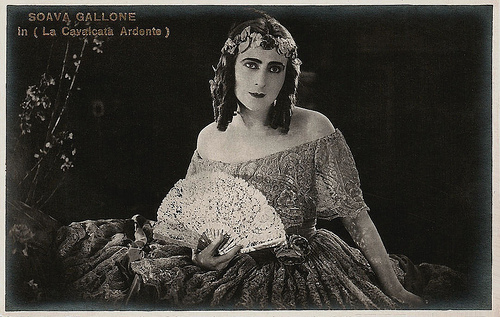
Italian postcard by Ed. G.B. Falci, Milano. Photo: Soava Gallone in La cavalcata ardente (1925).
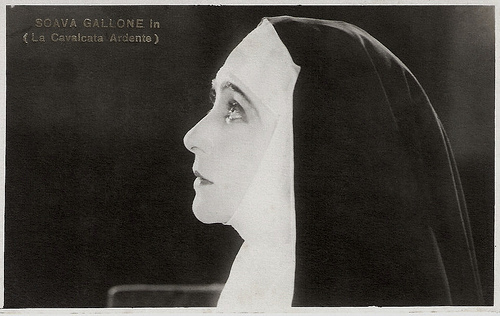
Italian postcard by G.B. Falci Editori, Milano. Photo: Soava Gallone in La cavalcata ardente (1925).
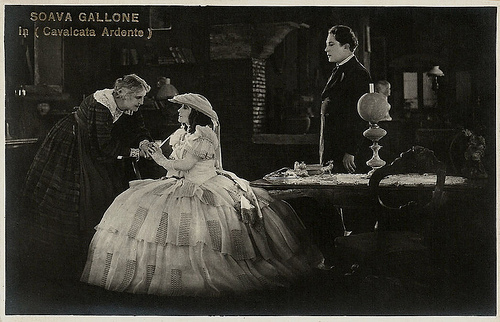
Italian postcard by Ed. G.B. Falci, Milano. Photo: Jeanne Brindeau, Soava Gallone and Gabriel de Gravone in La cavalcata ardente (1925).
A Refined, Delicate Soul
Carmine Gallone had the intelligence to pick films that fully sustained the image of Soava Gallone as a refined, delicate soul, and he limited her performances to no more than two per year.
In La cavalcata ardente Soava plays a beautiful aristocratic girl, who has to hide in a convent. The photography was by Alfredo Donelli and Emilio Guattari. The costumes were designed by French fashion designer Paul Poiret and the sets by Filippo Folchi.
Director Gallone wrote the script himself. The film had its premiere in the Supercinema (now Teatro Nazionale) in Rome in April 1925. In the audience were many of the old veterans of Giuseppe Garibaldi's volunteer army dressed in their shirts. The reviewer of the magazine L'epoca praised the combination of the love story and the historical background.
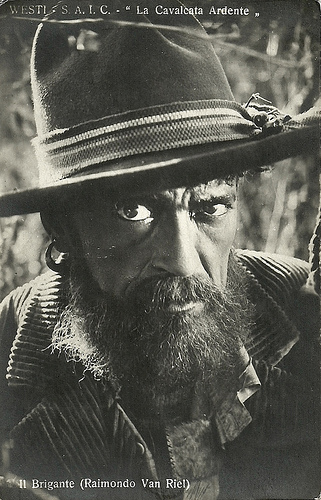
Italian postcard by Ed. G.B. Falci, Milano. Photo: Westi / S.A.I.C. Publicity still of Raimondo Van Riel as Il Brigante (The Bandit) in La cavalcata ardente (1925).
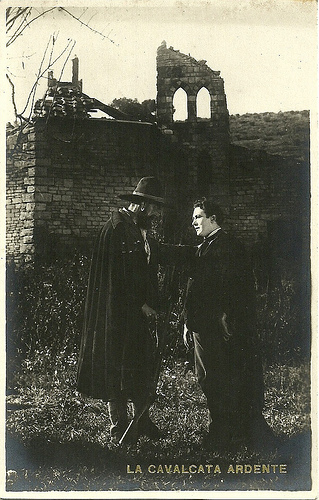
Italian postcard by Ed. G.B. Falci, Milano. Photo: Raimondo Van Riel and Gabriel de Gravone in La cavalcata ardente (1925).
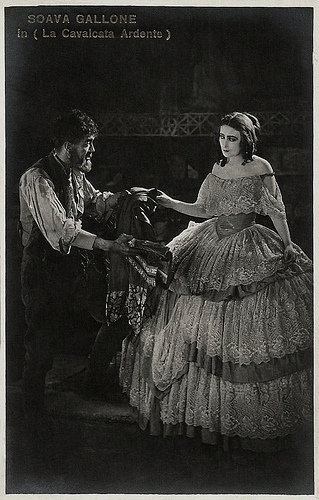
Italian postcard by Ed. G.B. Falci, Milano. Photo: Raimondo Van Riel and Soava Gallone in La cavalcata ardente (1925).
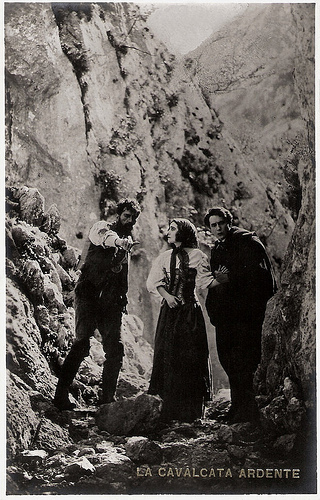
Italian postcard by Ed. G.B. Falci, Milano. Photo: Raimondo Van Riel, Soava Gallone and Gabriel de Gravone in La cavalcata ardente (1925).
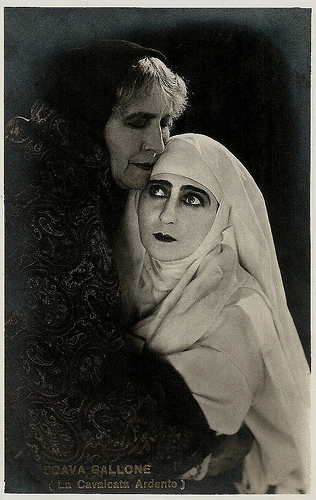
Italian postcard by Ed. G.B. Falci, Milano. Photo: Jeanne Brindeau and Soava Gallone in La cavalcata ardente (1925).
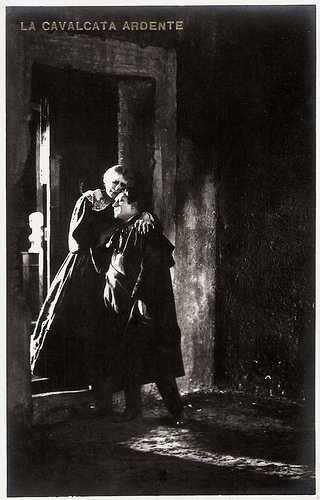
Italian postcard by Ed. G.B. Falci, Milano. Photo: Jeanne Brindeau and Gabriel de Gravone in La cavalcata ardente (1925).
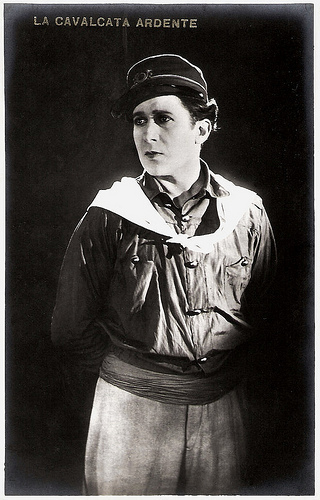
Italian postcard by Ed. G.B. Falci, Milano. Photo: Gabriel de Gravone in La cavalcata ardente (1925).
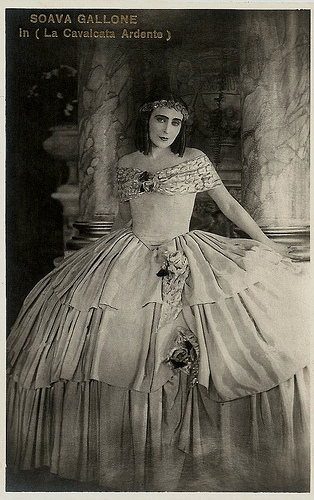
Italian postcard by Ed. G.B. Falci, Milano. Photo: Soava Gallone in La cavalcata ardente (1925).
Secretly in Love
La cavalcata ardente is a melodrama set against the background of the conquest of Naples by Giuseppe Garibaldi's volunteers in 1860.
Soava Gallone plays Grazia di Montechiaro, an aristocratic who is forced into a marriage with the old prince of Santafè ( Emilio Ghione ). She is secretly in love with a patriot ( Gabriel de Gravone ).
Masked, the lover leads a cavalry to save the girl during the betrothal party (hence the fiery cavalcade of the title). This leads to the girl hiding in a convent and the lover reaching for the troupes of Garibaldi. He is arrested, however, and the girl can only save his life by accepting marriage with the old prince.
However, she is saved for a second time, as Garibaldi’s troupes just in time reach Naples and the old prince dies in the following battle. At the end the two lovers are finally reunited.
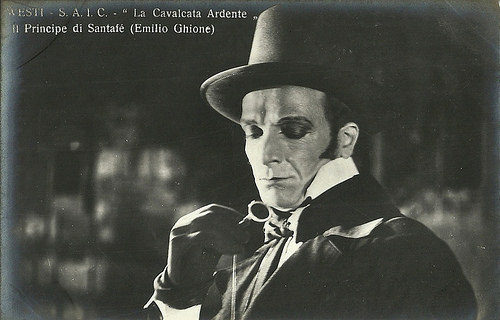
Italian postcard by Ed. G.B. Falci, Milano. Photo: Westi / S.A.I.C. Publicity still of Emilio Ghione as the Prince of Santafé in La cavalcata ardente (1925).
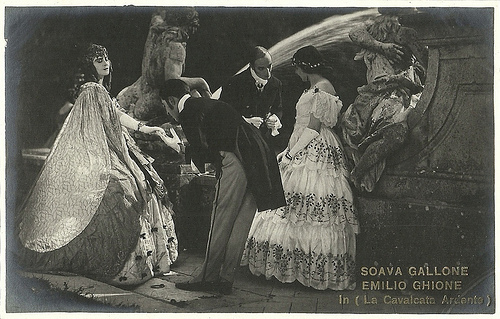
Italian postcard by Ed. G.B. Falci, Milano, no 312. Photo: Soava Gallone and Emilio Ghione in La cavalcata ardente (1925).
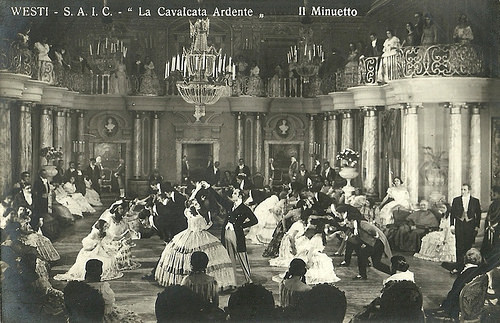
Italian postcard by Ed. G.B. Falci, Milano. Photo: Westi / S.A.I.C. Publicity still of Soava Gallone and Emilio Ghione in La cavalcata ardente (1925).
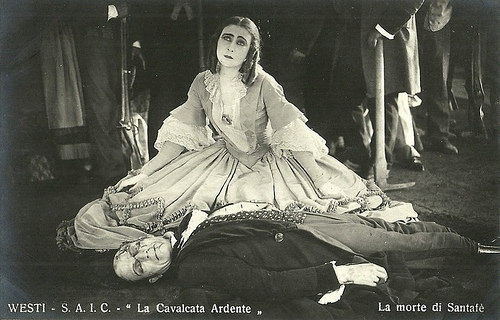
Italian postcard by Ed. G.B. Falci, Milano. Photo: Westi / S.A.I.C. Publicity still of Soava Gallone and Emilio Ghione in La cavalcata ardente (1925). Caption: "The death of Santafé."
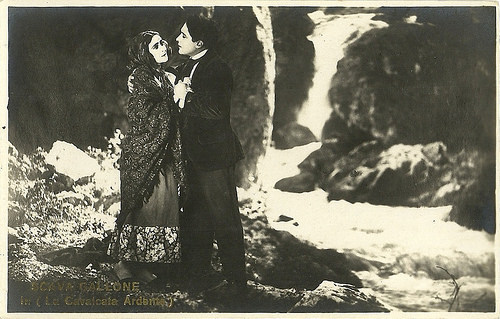
Italian postcard by Ed. G.B. Falci, Milano, no 318. Photo: Soava Gallone and Gabriel de Gravone in La cavalcata ardente (1925).
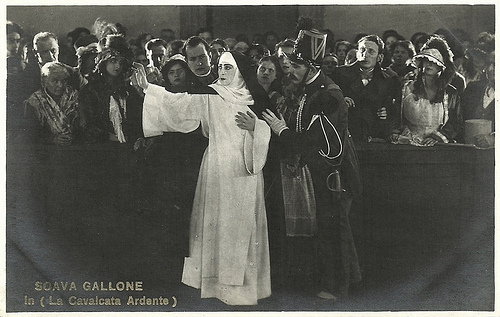
Italian postcard by Ed. G.B. Falci, Milano. Photo of Soava Gallone in La cavalcata ardente (1925).
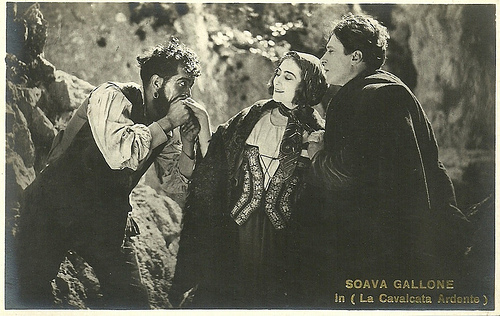
Italian postcard by Ed. G.B. Falci, Milano. Photo: Raimondo Van Riel, Soava Gallone and Gabriel de Gravone in La cavalcata ardente (1925).
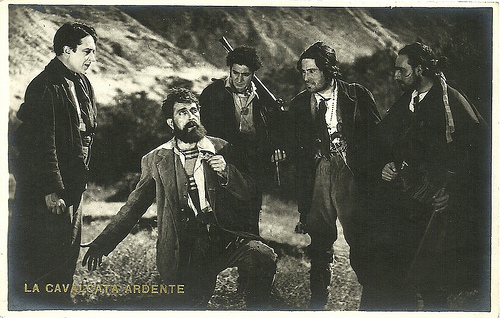
Italian postcard by Ed. G.B. Falci, Milano. Photo: Raimondo Van Riel, and Gabriel de Gravone in La cavalcata ardente (1925).
Sources: Vittorio Martinelli (Le dive del silenzio), Vittorio Martinelli (Il cinema muto italiano), Wikipedia (Italian) and IMDb.

Italian postcard by Ed. G.B. Falci, Milano. Photo: Soava Gallone in La cavalcata ardente (1925).

Italian postcard by G.B. Falci Editori, Milano. Photo: Soava Gallone in La cavalcata ardente (1925).

Italian postcard by Ed. G.B. Falci, Milano. Photo: Jeanne Brindeau, Soava Gallone and Gabriel de Gravone in La cavalcata ardente (1925).
A Refined, Delicate Soul
Carmine Gallone had the intelligence to pick films that fully sustained the image of Soava Gallone as a refined, delicate soul, and he limited her performances to no more than two per year.
In La cavalcata ardente Soava plays a beautiful aristocratic girl, who has to hide in a convent. The photography was by Alfredo Donelli and Emilio Guattari. The costumes were designed by French fashion designer Paul Poiret and the sets by Filippo Folchi.
Director Gallone wrote the script himself. The film had its premiere in the Supercinema (now Teatro Nazionale) in Rome in April 1925. In the audience were many of the old veterans of Giuseppe Garibaldi's volunteer army dressed in their shirts. The reviewer of the magazine L'epoca praised the combination of the love story and the historical background.

Italian postcard by Ed. G.B. Falci, Milano. Photo: Westi / S.A.I.C. Publicity still of Raimondo Van Riel as Il Brigante (The Bandit) in La cavalcata ardente (1925).

Italian postcard by Ed. G.B. Falci, Milano. Photo: Raimondo Van Riel and Gabriel de Gravone in La cavalcata ardente (1925).

Italian postcard by Ed. G.B. Falci, Milano. Photo: Raimondo Van Riel and Soava Gallone in La cavalcata ardente (1925).

Italian postcard by Ed. G.B. Falci, Milano. Photo: Raimondo Van Riel, Soava Gallone and Gabriel de Gravone in La cavalcata ardente (1925).

Italian postcard by Ed. G.B. Falci, Milano. Photo: Jeanne Brindeau and Soava Gallone in La cavalcata ardente (1925).

Italian postcard by Ed. G.B. Falci, Milano. Photo: Jeanne Brindeau and Gabriel de Gravone in La cavalcata ardente (1925).

Italian postcard by Ed. G.B. Falci, Milano. Photo: Gabriel de Gravone in La cavalcata ardente (1925).

Italian postcard by Ed. G.B. Falci, Milano. Photo: Soava Gallone in La cavalcata ardente (1925).
Secretly in Love
La cavalcata ardente is a melodrama set against the background of the conquest of Naples by Giuseppe Garibaldi's volunteers in 1860.
Soava Gallone plays Grazia di Montechiaro, an aristocratic who is forced into a marriage with the old prince of Santafè ( Emilio Ghione ). She is secretly in love with a patriot ( Gabriel de Gravone ).
Masked, the lover leads a cavalry to save the girl during the betrothal party (hence the fiery cavalcade of the title). This leads to the girl hiding in a convent and the lover reaching for the troupes of Garibaldi. He is arrested, however, and the girl can only save his life by accepting marriage with the old prince.
However, she is saved for a second time, as Garibaldi’s troupes just in time reach Naples and the old prince dies in the following battle. At the end the two lovers are finally reunited.

Italian postcard by Ed. G.B. Falci, Milano. Photo: Westi / S.A.I.C. Publicity still of Emilio Ghione as the Prince of Santafé in La cavalcata ardente (1925).

Italian postcard by Ed. G.B. Falci, Milano, no 312. Photo: Soava Gallone and Emilio Ghione in La cavalcata ardente (1925).

Italian postcard by Ed. G.B. Falci, Milano. Photo: Westi / S.A.I.C. Publicity still of Soava Gallone and Emilio Ghione in La cavalcata ardente (1925).

Italian postcard by Ed. G.B. Falci, Milano. Photo: Westi / S.A.I.C. Publicity still of Soava Gallone and Emilio Ghione in La cavalcata ardente (1925). Caption: "The death of Santafé."

Italian postcard by Ed. G.B. Falci, Milano, no 318. Photo: Soava Gallone and Gabriel de Gravone in La cavalcata ardente (1925).

Italian postcard by Ed. G.B. Falci, Milano. Photo of Soava Gallone in La cavalcata ardente (1925).

Italian postcard by Ed. G.B. Falci, Milano. Photo: Raimondo Van Riel, Soava Gallone and Gabriel de Gravone in La cavalcata ardente (1925).

Italian postcard by Ed. G.B. Falci, Milano. Photo: Raimondo Van Riel, and Gabriel de Gravone in La cavalcata ardente (1925).
Sources: Vittorio Martinelli (Le dive del silenzio), Vittorio Martinelli (Il cinema muto italiano), Wikipedia (Italian) and IMDb.
Published on May 08, 2015 22:00
May 7, 2015
Ulrich Thein
German actor, film director and screenwriter Ulrich Thein (1940–1995) appeared in 44 films and television shows between 1952 and 1995. His film Romanze mit Amélie/Romance with Amelie (1982) was entered into the 32nd Berlin International Film Festival.
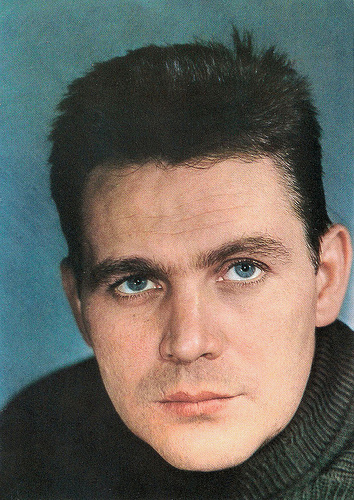
East-German postcard by VEB Progress Film-Vertrieb, no. 2265, 1965. Retail price: 0,15 MDN. Photo: Schwarzer.
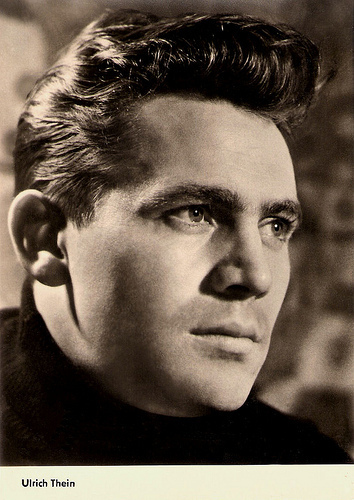
East-German postcard by VEB Progress Film-Vertrieb, no. 1613, 1961. Retail price: 0,20 DM. Photo: A. Paskowiak.
DEFA Thriller
Ulrich Thein was born in Braunschweig (Brunswick), Germany in 1940. He was the son of a theatre conductor and grew up under difficult conditions. His father died when Ulrich was four years old, and his mother, Else Thein, had to manage the family (Thein had two older brothers).
After high school, Thein studied music (harp and piano), and took acting classes. He got an engagement at the Staatstheater Braunschweig. In 1951 he moved over to East Germany and got his first role as the youngest member of the Deutsches Theater in Berlin, where he remained until 1963.
He also played at the Theater der Freundschaft in Berlin (now Theater an der Parkaue) and was then actor and director at the Theater der Bergarbeiter(Theater of the miners) in Senftenberg.
Ulrich started his film career with the DEFA thriller Geheimakten Solvay/Secret Files of Solvay (Martin Hellberg, 1952) with Leny Marenbach .
In 1954 he played a supporting part in the crime film Alarm im Zirkus/Alarm in the Circus (Gerhard Klein, 1954) starring Erwin Geschonneck. This film was based on true events. In 1953 a robbery of horses at Circus Barlay had been foiled and the screenplay was based on the press reports. With 3.6 million filmgoers, Alarm im Zirkus became the blockbuster of the year in East-Germany.
From then on Ulrich Thein played numerous roles in films by Martin Hellberg, Frank Beyer and Konrad Wolf. Among his other early DEFA films were Thomas Müntzer – Ein Film deutscher Geschichte/Thomas Müntzer (Martin Hellberg, 1956), Das Lied der Matrosen/The Sailor's Song (Kurt Maetzig, Günter Reisch, 1958) and SAS 181 antwortet nicht/SAS 181 Does Not Answer (Carl Ballhaus, 1959).
For the crime film Spur in die Nacht/Track in the night (Günter Reisch, 1957) he also was involved in the soundtrack for which he composed the Fuchsbau-Boogie (Burrow Boogie).
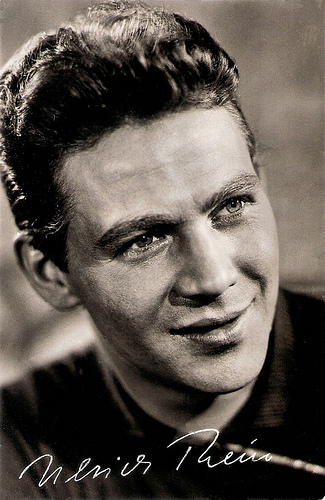
East-German postcard by VEB Progress Film-Vertrieb, no. 3941/431, 1957. Retail price: 0,20 DM. Photo: DEFA / Wunsch.
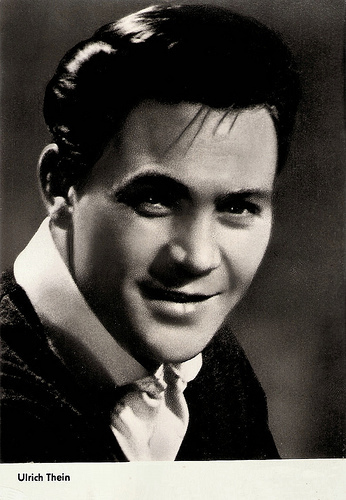
East-German postcard by VEB Progress Film-Vertrieb, no. 1675, 1962. Retail price: 0,20 DM. Photo: A. Paskowiak.
Johann Sebastian Bach
In the early 1960s, Ulrich Thein continued to star in several East-German films, including the war drama Fünf Patronenhülsen/Five Cartridges (Frank Beyer, 1960) co-starring Armin Mueller-Stahl , the drama Professor Mamlock (Konrad Wolf, 1961) featuring Wolfgang Heinz, Septemberliebe/September Love (Kurt Maetzig, 1961), Königskinder/Star-Crossed Lovers (Frank Beyer, 1962) with Annekathrin Bürger, and Chronik eines Mordes/The Story of a Murder (Lothar Bellag, 1965) opposite Angelica Domröse .
In 1963 he wrote for the first time the script for a TV film, Der andere neben dir/The other one next to you, which he also directed successfully. For one and a half decades, Thein was one of the most successful television directors of the GDR. He took on important current themes again and again. He directed carefully and with much feeling for detail.
Since the late 1970s he made a come-back as a television actor in the series Polizeiruf 110/Police 110 (1977-1990). He also convincingly played the title roles in the biopics Martin Luther (Kurt Veth, 1982) and Johann Sebastian Bach (Lothar Bellag, 1983).
In 1982, he directed the film Romanze mit Amélie/Romance with Amelie (Ulrich Thein, 1982), which was entered into the 32nd Berlin International Film Festival. Thein became member of the Akademie der Künste der DDR (Academy of Arts of the GDR) in 1985, which he left in 1991 in protest against the terms of the unification of East and West-German Academies.
After the liquidation of the East-German television broadcaster DFF, he declined many ‘trivial’ offers by producers. From 1992 on, he worked as a lecturer at the Drama School Ernst Busch in Berlin. In addition to his work as an actor and director, Thein was also a pianist and he composed songs for his films.
His last film appearance was in the TV film Blutige Spur/Bloody Trail (Carlo Rola, 1995) starring Jan Niklas.
Ulrich Thein died in 1995 in Berlin. He was 54. His partners in life and in the cinema have included the actresses Christel Thein-Sörgel, Annekathrin Bürger und Renate Geißler. He was married to actress Jana Brejchová and after their divorce to actress Franziska Troegner till his death.
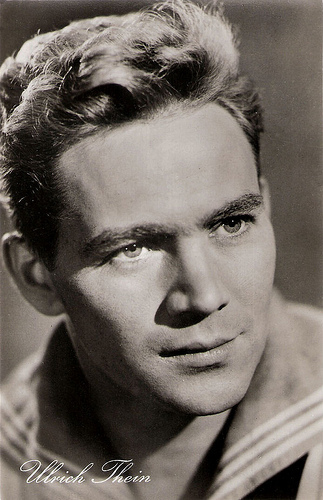
East-German postcard by VEB Progress Film-Vertrieb, no. 880, 1958. Retail price: 0,20 DM. Photo: DEFA. Publicity still for Das Lied der Matrosen/The Sailor's Song (Kurt Maetzig, Günter Reisch, 1958).
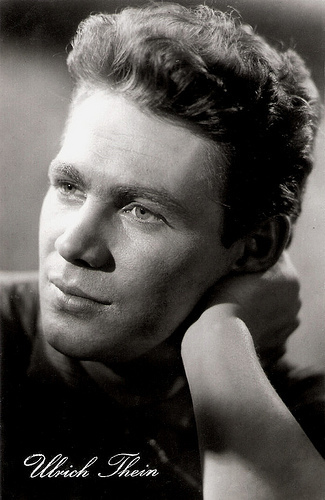
East-German postcard by VEB Progress Film-Vertrieb, no. 3943/657, 1958. Retail price: 0,20 DM. Photo: DEFA / Wunsch.
Sources: Wikipedia (German and English) and .

East-German postcard by VEB Progress Film-Vertrieb, no. 2265, 1965. Retail price: 0,15 MDN. Photo: Schwarzer.

East-German postcard by VEB Progress Film-Vertrieb, no. 1613, 1961. Retail price: 0,20 DM. Photo: A. Paskowiak.
DEFA Thriller
Ulrich Thein was born in Braunschweig (Brunswick), Germany in 1940. He was the son of a theatre conductor and grew up under difficult conditions. His father died when Ulrich was four years old, and his mother, Else Thein, had to manage the family (Thein had two older brothers).
After high school, Thein studied music (harp and piano), and took acting classes. He got an engagement at the Staatstheater Braunschweig. In 1951 he moved over to East Germany and got his first role as the youngest member of the Deutsches Theater in Berlin, where he remained until 1963.
He also played at the Theater der Freundschaft in Berlin (now Theater an der Parkaue) and was then actor and director at the Theater der Bergarbeiter(Theater of the miners) in Senftenberg.
Ulrich started his film career with the DEFA thriller Geheimakten Solvay/Secret Files of Solvay (Martin Hellberg, 1952) with Leny Marenbach .
In 1954 he played a supporting part in the crime film Alarm im Zirkus/Alarm in the Circus (Gerhard Klein, 1954) starring Erwin Geschonneck. This film was based on true events. In 1953 a robbery of horses at Circus Barlay had been foiled and the screenplay was based on the press reports. With 3.6 million filmgoers, Alarm im Zirkus became the blockbuster of the year in East-Germany.
From then on Ulrich Thein played numerous roles in films by Martin Hellberg, Frank Beyer and Konrad Wolf. Among his other early DEFA films were Thomas Müntzer – Ein Film deutscher Geschichte/Thomas Müntzer (Martin Hellberg, 1956), Das Lied der Matrosen/The Sailor's Song (Kurt Maetzig, Günter Reisch, 1958) and SAS 181 antwortet nicht/SAS 181 Does Not Answer (Carl Ballhaus, 1959).
For the crime film Spur in die Nacht/Track in the night (Günter Reisch, 1957) he also was involved in the soundtrack for which he composed the Fuchsbau-Boogie (Burrow Boogie).

East-German postcard by VEB Progress Film-Vertrieb, no. 3941/431, 1957. Retail price: 0,20 DM. Photo: DEFA / Wunsch.

East-German postcard by VEB Progress Film-Vertrieb, no. 1675, 1962. Retail price: 0,20 DM. Photo: A. Paskowiak.
Johann Sebastian Bach
In the early 1960s, Ulrich Thein continued to star in several East-German films, including the war drama Fünf Patronenhülsen/Five Cartridges (Frank Beyer, 1960) co-starring Armin Mueller-Stahl , the drama Professor Mamlock (Konrad Wolf, 1961) featuring Wolfgang Heinz, Septemberliebe/September Love (Kurt Maetzig, 1961), Königskinder/Star-Crossed Lovers (Frank Beyer, 1962) with Annekathrin Bürger, and Chronik eines Mordes/The Story of a Murder (Lothar Bellag, 1965) opposite Angelica Domröse .
In 1963 he wrote for the first time the script for a TV film, Der andere neben dir/The other one next to you, which he also directed successfully. For one and a half decades, Thein was one of the most successful television directors of the GDR. He took on important current themes again and again. He directed carefully and with much feeling for detail.
Since the late 1970s he made a come-back as a television actor in the series Polizeiruf 110/Police 110 (1977-1990). He also convincingly played the title roles in the biopics Martin Luther (Kurt Veth, 1982) and Johann Sebastian Bach (Lothar Bellag, 1983).
In 1982, he directed the film Romanze mit Amélie/Romance with Amelie (Ulrich Thein, 1982), which was entered into the 32nd Berlin International Film Festival. Thein became member of the Akademie der Künste der DDR (Academy of Arts of the GDR) in 1985, which he left in 1991 in protest against the terms of the unification of East and West-German Academies.
After the liquidation of the East-German television broadcaster DFF, he declined many ‘trivial’ offers by producers. From 1992 on, he worked as a lecturer at the Drama School Ernst Busch in Berlin. In addition to his work as an actor and director, Thein was also a pianist and he composed songs for his films.
His last film appearance was in the TV film Blutige Spur/Bloody Trail (Carlo Rola, 1995) starring Jan Niklas.
Ulrich Thein died in 1995 in Berlin. He was 54. His partners in life and in the cinema have included the actresses Christel Thein-Sörgel, Annekathrin Bürger und Renate Geißler. He was married to actress Jana Brejchová and after their divorce to actress Franziska Troegner till his death.

East-German postcard by VEB Progress Film-Vertrieb, no. 880, 1958. Retail price: 0,20 DM. Photo: DEFA. Publicity still for Das Lied der Matrosen/The Sailor's Song (Kurt Maetzig, Günter Reisch, 1958).

East-German postcard by VEB Progress Film-Vertrieb, no. 3943/657, 1958. Retail price: 0,20 DM. Photo: DEFA / Wunsch.
Sources: Wikipedia (German and English) and .
Published on May 07, 2015 22:00
Paul van Yperen's Blog
- Paul van Yperen's profile
- 13 followers
Paul van Yperen isn't a Goodreads Author
(yet),
but they
do have a blog,
so here are some recent posts imported from
their feed.



